
Inventing The
COVID VACCINE Does It Hold The Key To Curing Other Viruses?
PEDAL POWER
How Cycling Became A Quiet Revolution
DOPAMINE DRESSING Colours To Make You Happy 5



Inventing The
COVID VACCINE Does It Hold The Key To Curing Other Viruses?
PEDAL POWER
How Cycling Became A Quiet Revolution
DOPAMINE DRESSING Colours To Make You Happy 5

After spending far too much time on apps and social media over the last few years, Gemma decided it was time for a change.
“I’d started to get really frustrated with how I was spending my spare time”, said Gemma, 54 from London. “One day, I realised I’d checked my phone over 100 times. Something had to give.”
“So, I deleted my social media apps from my phone and made a promise to myself to do something more positive with my time.”
At first, it wasn’t easy for Gemma to find things to do.
“I’m embarrassed to admit that I’d stopped reading as much over the last couple of years. But, then a friend recommended Readly to me. I’d always loved reading magazines and thought it was time to give them a go again.
The selection is amazing: food, fitness, lifestyle, culture, crafts and

hobbies are all covered. I’ve been using Readly in the evenings to relax instead of watching TV. I’ve also found it great for inspiration and ideas for new recipes. We’ve been doing some re-decorating, so the interior design section has been really helpful. Having so many past issues to browse through is just fantastic. I can’t think how much I would’ve had to spend to get all that content. If you read more than a couple of magazines, you’ll be saving money each month.
My husband loves the car, sport and business magazines. And we cuddle up and do the puzzles and crosswords together now as well!
As it’s a family membership, I’ve shared my subscription with my daughter who has started using it. She’s a teacher and loves getting inspiration from the kids news, science and history magazines.”
To find out more about Readly, and to try 1 month for free, please go to www.readly.com/digest
16 IT’S A MANN’S WORLD
Olly Mann on the perks and perils of his new-found passion: recording audiobooks
ENTERTAINMENT
20 INTERVIEW:
MADS MIKKELSEN
The star of Hannibal and Casino Royale reveals his tips for mindfulness and the reason he took up dancing
28 “I REMEMBER”: LAURENCE
LLEWELYN-BOWEN
The celebrity interior designer opens up about childhood, marriage and paparazzi clashes
HEALTH
36 INVENTING THE COVID VACCINE
How did we get here and does it hold the key to curing other viruses?
54 WARNING SIGNS OF DEMENTIA
A guide to 13 symptoms
you should never ignore


INSPIRE
70 EXTRAS WITH A DIFFERENCE
How some of the finest exmilitary heroes are forging new careers on the silver screen
88 HARP SEALS
Discover the icy beauty of Magdalen Islands, home to the adorable Atlantic seal pups
94 PEDAL POWER
How cycling became a quiet revolution













Everything
a grandmother would ever want to pass on to her grandchildren
where she came from what she did what she learnt
all in one
incomparable volume
It’s time to tell your story

Don’t putoffit
The gift of a lifetime
LifeBook is the world’s leading memoir and autobiography service. Around the world thousands of people already enjoy owning the story of someone they love. Each book is a unique piece of family treasure, custom-made and handcrafted to be loved and shared by generations to come. It’s time for you to tell your story. Find out more by calling us on 0800 999 2280 or by visiting lifebookuk.com
SENIOR EDITORS Anna Walker, Eva Mackevic
EDITORIAL ASSISTANT Marco Marcelline
ART DIRECTOR Richard Cooke
ADVERTISING Jigs Pankhania
HEAD OF FINANCE Santwana Singh
FINANCE MANAGER Irving Efren
MANAGING DIRECTOR Julie Leach
CHAIRMAN Gary Hopkins
TRUSTED MEDIA BRANDS INC (USA)
President and Chief Executive Officer
Bonnie Kintzer
Editor-in-Chief, International Magazines
Bonnie Munday
WE PAY...
£50 for the star letter and £30 for regular letters.
Email readersletters@readers digest.co.uk or go to readers digest.co.uk/contact-us
WE ALSO PAY...
£30 for the true stories, anecdotes, jokes in Laugh! and You Couldn’t Make It Up…, and contributions to end-ofarticle fillers and My Great Escape
Email excerpts@readersdigest.co.uk or go to readersdigest.co.uk/contact-us
We cannot acknowledge or return unpublished items or unsolicited article-length manuscripts. Do not send SAEs. Article-length stories, poetry and cartoons are not requested.
Contact Customer Services for renewals, gifts, address changes, payments, account information and all other enquiries. Call 0330 333 2220* or email customer_service@readersdigest.co.uk
Reader’s Digest is also available in audio and accessible etext editions from RNIB Newsagent, for blind and partially sighted readers. Call the RNIB Helpline on 0303 123 9999 or visit rnib.org.uk/newsagent
Annual subscriptions are available to be delivered monthly direct to your door. For our latest offers please visit readersdigest.co.uk/subscribe Or telephone us today on 01778 392461.
Gift subscriptions also available.
UK rates may vary. Overseas rates: Republic of Ireland £45, Europe £50 and Rest of the World £60 for 12 month subscription.














PowerZoom Max are the NEW magnifying glasses with built-in LED lights which let you see everything clearer, bigger and brighter...even in low light conditions!
These innovative glasses deliver instant magnification of up to 160%! Plus, the super bright built-in LED lights let you see every little detail even in the dark. Already wear glasses? No problem! These magnifying glasses can be worn over your prescription glasses or contact lenses for extra magnification and clarity. You will see the difference instantly! Turn tricky activities such as threading needles, reading smallprint, hobbies and crafts into tasks that are easy and enjoyable.
And, with the powerful built-in LED lights, you will be able to read in the evenings in bed or work in low light areas without straining your eyes. Power Zoom Max lenses are scratch resistant and offer excellent sharpness, along with 160% magnification. Power Zoom Max suits everyone.













FREE OFFER! Order one pair of PowerZoom Max glasses with carrying pouch and get another pair free! Plus... every order comes with a free pair of Aviator style sunglasses with their own hard carrying case. Total value of £83.98 — all yours today for just £29.99!











If you’d told me in the early days of the coronavirus pandemic that we’d one day have a Reader’s Digest cover story about the development of a vaccine, I’d have been thrilled—and here we are. Scientists and researchers across the globe have achieved the seemingly impossible, creating numerous vaccines for the COVID-19 virus in record-breaking time. But it does beg the question—if this is how fast we can cure a virus when it holds the world’s attention, what else could we achieve if the greatest minds in science had cause to collaborate more regularly?
On p36 our writer Drew Turney poses this very question, and speaks to the experts on the possibilities coronavirus vaccines have opened up for other diseases, viruses and health concerns.
Also in this issue, we talk to the extravagant TV personality
Laurence LlewelynBowen about the beginnings of his love of uniforms, meeting his wife and being hounded by the paparazzi. As someone who loves flashy clothes and bold colours, I was overjoyed to learn about the experiences that shaped one of Britain’s best dressed men (by my standards, anyway). Read all about Laurence’s obsession with purple ceilings and heraldry on p28.

And speaking of style, our music page this month is dedicated to another famously dapper man, Miles Davis. On p121, we celebrate his scintillating 1991 performance in France, which sadly turned out to be one of his last. Sporting his bright-red, kimono-style shirt and signature sunglasess, he was as much of a fashion icon as he was a musical one.
facebook.com/readersdigestuk
twitter.com/readersdigestuk
@readersdigest_uk
You can also sign up to our newsletter at readersdigest.co.uk
Reader’sDigestis published in 27 editions in 11 languages
LETTERS ON THE May ISSUE
We pay £50 for Letter of the Month and £30 for all others

I can completely relate to Dame Helen Mirren’s experience of bonding with her husband during lockdown. Like Helen, I travelled frequently with work and spent countless weekends in hotels with only limp tea bags, miniscule biscuits and coat-hangerrearranging neighbours for company. During lockdown, however, my husband and I have re-discovered our comfortable togetherness and become travel buddies without leaving our own patio. For the cost of a mini-break, last spring we treated ourselves to a half-decent telescope
Olly Mann’s column, “Rocket Science” was such an enjoyable piece. It made me laugh and l learned a few new words along the way too (“apocryphal” and “acquiesced”, please don’t judge me). The article took me back to my childhood, nostalgic about all my favourite
and have become dab hands at amateur astronomy. At twilight, we head outside with a flask of tea and embark on celestial voyages. We have observed Saturn’s rings, basked in Mars’ crimson glow and lost ourselves in the Milky Way. We have been awed by spectacular meteor light shows, even when cloud cover made the Orionids more drip than shower. Each night, we sit side by side, raise our mugs of heavenly tea to the international space station as it zooms silently overhead and thank our lucky stars for these ordinary, yet extraordinary shared times together.
MARY ROSS, via emailtoys, the best of which were not expensive at all. I have five siblings, had to share and l give my mum major kudos wondering how she managed it all. I have three kids of my own now and toys have been an ever-constant battle. I have learned from your experience and mine that not all toys are created
equal. Learning when to give in and when to stand firm is one of the inner battles of parenting that l constantly wrestle with. I have been served many humble pies in my journey and l laughed when l read yours, thankful it was not just me.
ABIODUN FAGBEJA, Portishead

Having previously read Dr Edith Eger’s book, The Choice, I was delighted to see your feature “I Remember…” in the May issue. Dr Eger, author, psychologist and Holocaust survivor, shows us how— during even the most trying and turbulent times—it is always possible to remain positive and compassionate. For her to have experienced the most unimaginable horrors at such a young age, and then to live a life free of bitterness and resentment, committed to improving the mental health of others, makes her a true inspiration. For those of us struggling with the effects of the coronavirus pandemic, Dr Eger provides an invaluable lesson in how to endure the things we cannot change, focus on the things that bring us joy, and to look after our fellow man.
Dr Eger has given me the confidence to know that I have the strength to survive the struggles of living through a pandemic, my chronic health issues, and whatever else life chooses to throw at me!
ALISON FRY, East Sussex
I was fascinated to read the story behind the L’Oreal, “Because you’re worth it” tag line. Although, I have to confess I’ve never really liked the adverts. The model’s hair is always too sleek and perfect and I still get the impression that women are being forced to conform to a certain ideal, which for most of us is impossible to achieve. Whatever I do to my hair, it never ever looks as good as the adverts! What I do support, though, is the empowerment of women and I love Dame Helen Mirren’s idea of valuing not beauty but agency in the form of “swagger.” Perhaps L’Oreal should take note and start selling bottles of “swagger” instead. I think they’d get my custom then!
JENNIE GARDNER, Bath
Equity release can help you to access tax-free cash from the value of your home. With a Lifetime Mortgage, the UK’s most popular form of equity release, you can access your property’s wealth in a tax-free lump sum or reserve some funds for later use. Releasing equity is a great way to gain funds in later life because there are no required affordability checks, with how much you can release being primarily determined by the value of the home and the age of the youngest homeowner instead.
Lifetime Mortgages can be highly varied and include different features to protect your interests, based on your unique situation. Reader’s Digest Equity Release source products from many different

lenders and are proud to provide our customers with products that offer great value for you and your family, both now and in the future. Your adviser will also discuss with you the alternatives to equity release, and the impact of each option, to reach a decision as to whether equity release is the best option for you.
The Equity Release Council (ERC) is the industry body which regulates the product and ensures the inclusion of specific securities which protect customers and help to reduce risk. These protections are very important and are at the forefront of the service that Reader’s Digest Equity Release provide.
With a Lifetime Mortgage you have the right to remain in your home for life and you will retain full ownership of your home. You will also never owe more than the value of your home thanks to the no-negative-equity guarantee built into all plans provided by ERC-approved lenders. The loan is repaid when the youngest homeowner no longer resides in the property, either after they have passed away or moved into permanent long-term care.
As you are releasing equity from your home now, the funds remaining for your estate may be reduced. An expert adviser will be able to help you to manage the effect releasing equity could have on the value of your estate and your entitlement to means-tested benefits. They will discuss the features and risks and provide you with a personalised illustration so that you can accurately view how the loan will change over time.
If you’re interested in how equity release can help you, call us today. n
Reader’s Digest Equity Release is a trading style of Responsible Life Limited. Only if you choose to proceed and your case completes will Responsible Life Limited charge an advice fee, currently not exceeding £1,490. Please note that due to restrictions face-to-face appointments may not be available in all areas. The Information Team will let you know the options available to you.


 Photo:© PI erre rochon/ a lamy s tock
Photo
Photo:© PI erre rochon/ a lamy s tock
Photo

Romanesco is a vegetable that should be particularly tasty to mathematicians, as it simultaneously displays two numerical phenomena. The spiral form of the bud follows a Fibonacci Sequence which is used in mathematics to determine “The Golden Ratio”, also known as the “most beautiful number”, because its proportions appear in everything from architecture to the human body. The plant also displays a fractal shape with its form in that each of the tiny green buds is a smaller copy of the larger head’s shape. Beyond that, Romanesco simply tastes good and is quite healthy, being rich with nutrients and vitamin C.
This month Olly Mann is excited to embark upon realising a life-long dream
Today, I’ve been recording an audiobook. That’s an exciting sentence to write; partly because, after eight hours of talking into a mic, writing anything provides a welcome break from talking. But also because— long before I ever heard the word "audiobook"—it’s something that I aspired to do.
At primary school, for instance, I vividly recall waiting with breathless anticipation to take my turn reading out a paragraph of The Ladybird Book of Cars, or some equally thrilling tome. The little hardback would be passed around

Olly Mann presents Four Thought for BBC Radio 4, and the award-winning podcasts The Modern Mann and Answer Me This!
the classroom, each child clumsily blundering through their allocated text before chucking the book at the pupil on their left.
I realised, of course, that the point of the exercise was to monitor our literacy and comprehension—not to entertain our fellow classmates, most of whom were busy flicking bogeys at each other. Nonetheless, I always performed my paragraph as if it were the sermon on the mount.
At my secondary school, students were encouraged to put themselves forward to select and present a reading at "morning talk"—a twiceweekly assembly—and I often added my name to the list. The school was non-denominational, so there was no expectation of piety: in fact, I went out of my way to push boundaries of taste. I once relished delivering a list of the average sizes of male genitalia from The Mackeson
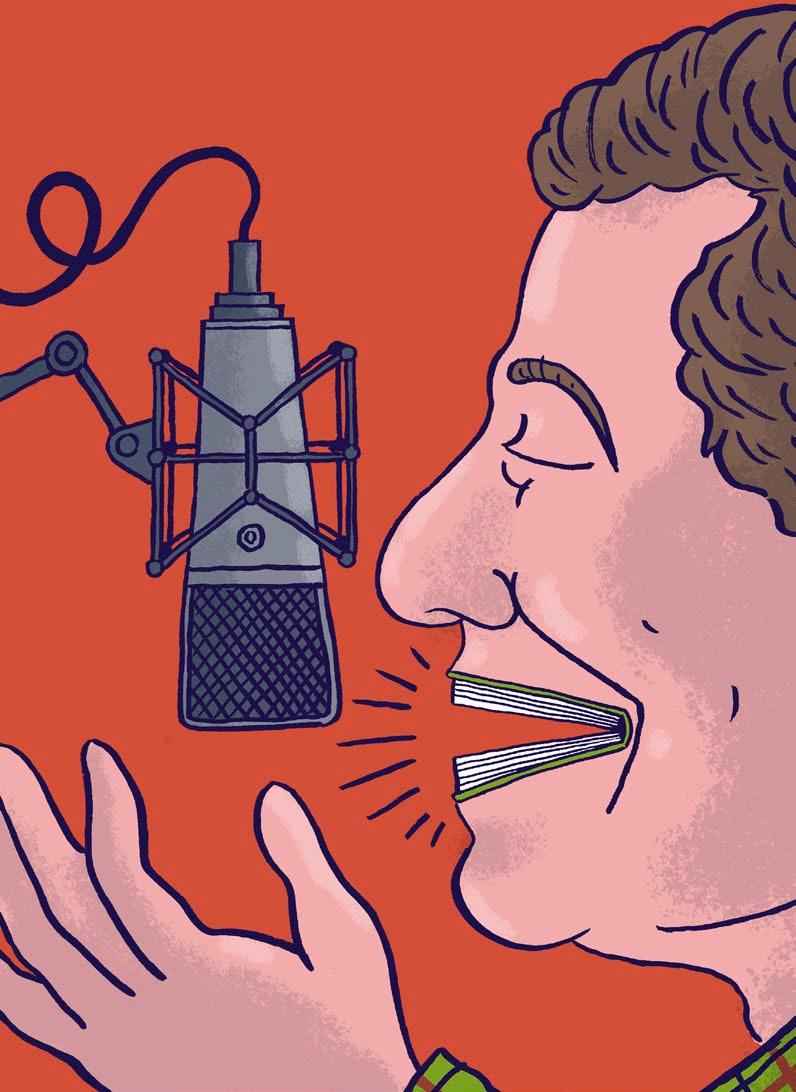
Book Of Averages, and, on another occasion, highlighted some racist fancy dress advice I’d found in an 1940s edition of The Girls Companion in the school library, hoping to embarrass the headteacher into buying some new books.

This was all handy background for a career in broadcasting. But, much as I enjoy hosting shows and interviewing people, I often find myself missing the simple pleasures of reading out loud. Having to structure one’s thoughts into prose leaves less brain-space to focus on delivery. But occupying someone else’s mind for a bit, and reading out their words, is comparatively stress-free.
I’d thought about putting myself forward as a narrator for audiobooks. But I’m not an actor. I can’t do regional accents (without offending plenty of people). And playing female parts triggers unwelcome flashbacks of my portrayal of Mrs Hogg in a school production of The Sheep-Pig—essentially channelling The Two Ronnies, which is not, I suspect, what most listeners expect in 2021.
Non-fiction, then, seemed the obvious genre to target, but as an avid consumer of audiobooks I felt instinctively that such titles were best read by their authors—I’ve
been utterly engrossed hearing memoirs by Andrew Neil, Maggie Thatcher, Peter Mandelson, Woody Allen, Fern Britton, David Mitchell, Nicholas Hytner, and many others, and felt they simply wouldn’t have resonated with me if it weren’t the protagonist’s own voices telling their stories.
Recently, delivering my son’s nightly bedtime story has rekindled my love for reading out loud—highlights so far have included Charlie and the Chocolate Factory and Charlotte’s Web, and, at one point, I even dusted down my Mrs Hogg. But I never thought I’d get the opportunity to do it professionally.
Then, last month, out of the blue, I was contacted by an audiobook production company! James Plunkett, author of End State, a forthcoming book about political ideas, was apparently 1) an introvert with no desire to read his book out loud, and 2) a fan of my podcasts, and thought I might do a reasonable job. Hurrah for policy wonks!
So, I’ve spent this week secreted in a studio, on the top floor of an anonymous business centre in Maida Vale, simply reading stuff out loud (albeit on an iPad, because the manuscript has only just been
sent to the printers, and the rustle of printed pages would cause obvious issues for the recording.) And I’m LOVING IT! Not least because my phone needs to be turned off. Days at a time, focused on one task, without multiple messages flashing up, is a holiday in itself.
Mind you, it’s not an entirely zen experience. The process has flagged up just how often I actually fluff my lines: about once per page, which I’ve been told is absolutely average, but still, it’s disheartening when the recording needs to be stopped because I’ve just inadvertently skipped over a "the", or had to clear my throat, or catch my breath. I’ve also learned, to my dismay, how many words I’ve been mispronouncing my entire life:
behavioural is BE-HAYVE-YOU-RAL, not BE-HAYVE-EE-AH-RUL; Friedrich Engels is FREED-RICK, not FRIEDRICK; and Thales of Miletus is THEYLEESE, not THAY-ULLS (albeit I’ve never had much prior cause to talk about him). The knight in shining armour has been youglish.com, a notfor-profit website that scours YouTube transcriptions to throw up real-time pronunciations from over 100 million videos. I’ve donated them a fiver in my sincerest gratitude.
Even though I’ve had to work evenings and weekends to make up for the all the daytime work hours I’ve lost while tackling this 339-page book, I’ve found the whole process sublime, and hope this becomes the first of many.
Fingers crossed for that reissue of The Mackeson Book of Averages… n
1) First cultivated in Iowa in 1872, what is the world’s most widely grown variety of apple?
2) Which scientist appeared on the first logo for the Apple Computer Company?
3) In Greek mythology, which goddess was awarded a golden apple for her beauty?
4) Which number one song was the Beatles’ first release on their Apple Records label?
5) Appleman is a foe of which British superhero?
6) The fictional painting "Boy with Apple" plays a major role in which Wes Anderson film?
7) Dating back to 1381, the earliest known recipe for apple pie was printed by which English author?
Danish actor Mads Mikkelsen, 55, might be the ultimate proof that it takes a good guy to play a really bad one. The king of the on-screen villain talks dance, booze and his most famous roles
It couldn’t happen to a nicer guy. It’s a phrase that aptly fits Mads Mikkelsen, the Danish actor who has become the king of franchise films these past years. Already he’s played villains in James Bond film Casino Royale and Marvel’s Doctor Strange, Thomas Harris’ serial killer Hannibal Lecter in TV show Hannibal and the bloke who designed the Death Star in Star Wars spin-off Rogue One. “I grew up with big Hollywood films, watching them,” he says. “All of a sudden, I’m part of that. And I love that.”
Even this past lockdown year, Mikkelsen has been winning at
life. “I was planning to learn a few languages. I never got around to it.” Instead, he played tennis, started building a summer cottage at his home in Copenhagen and bought a pet. “We spent a lot of time with a dog.” Married to choreographer Hanne Jacobsen since 2000, they’ve been together since 1987 (and have two children, Viola and Carl, in their twenties). “I’m pretty good at doing nothing,” he adds, “but a lot of things at the same time.”
We chat on Zoom, with Mikkelsen dressed in a neatly-pressed black shirt. His hair has blonde highlights, though his goatee is salt-and-pepper


grey. He’s 55 now, his face full of character and nobility, but has absolutely no issue with sullying his looks on screen—whether as 007’s scar-faced nemesis Le Chiffre in Casino Royale, or the one-eyed Viking in Nicolas Winding Refn’s Valhalla Rising. Mikkelsen is every performer’s dream: a character actor in a leading man’s body.
While some actors abandon their homeland the moment Hollywood comes calling, Mikkelsen has remained as active in Danish cinema as he was when he broke out 25 years ago, as a low-level thug in Refn’s
stylish crime debut Pusher. He’s repeatedly returned to directors like Refn, Susanne Bier (Open Hearts, After the Wedding) and Anders Thomas Jensen, director of the upcoming Riders of Justice, in which Mikkelsen thrills as a soldier who seeks revenge on the men who killed his wife.
“I think I’ve always been lucky and in a very privileged position,” he says. “They ask me over there to do certain things. And they ask me back here to do certain things, and they’re rarely crossing over each other’s ambitions. I kind of get my thirst quenched in
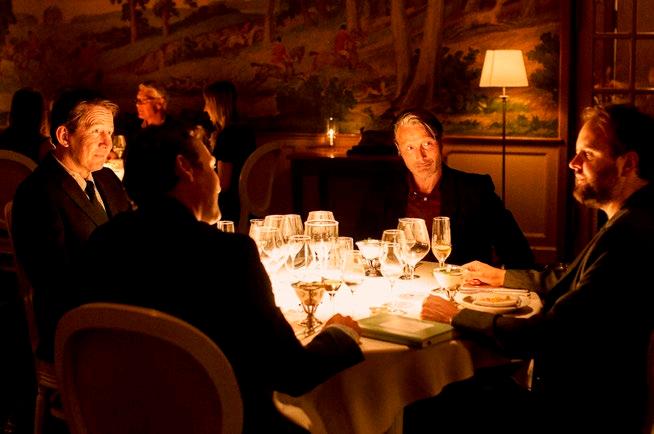
“SOMETIMES YOU JUST WANT TO GO OUT AND HAVE A SWORD IN YOUR HAND”
both places.” It’s an ideal position, flip-flopping between homespun character-driven dramas and the big-scale spectacle Hollywood offers. “Sometimes,” he grins, “you just want to go out and have a sword in your hand.”
If it’s usually the case of never the twain shall meet, that’s not so with Mikkelsen’s latest film Another Round—a life-affirming Danish drama that recently won the Oscar for Best Foreign Language Film. Mikkelsen was nominated for a BAFTA for his performance, while
Leonardo DiCaprio’s company Appian Way has already bought the remake rights. It’s a remarkable trajectory for a subtitled movie about a schoolteacher who decides to experiment with day-time drinking.
Suffering from mid-life malaise, his mopey character Martin almost feels the polar opposite to the upbeat Mikkelsen. “I mean, I do tend to wake up in the morning and be very, very pleased that the sun is rising and curious about what the day might bring,” he says. “And [the character] seems not to care about it at all. So I didn’t have anything in common with

him, from that perspective. I mean, I know the character. I know a lot of people like that. I know the feeling. But I’m not in his situation.”
Things change when Martin and three friends decide to test out a real theory first suggested by a Norwegian psychiatrist Finn Skarderud: if humans raise their blood alcohol level to 0.05 per cent, they might achieve more. It’s the old adage about Dutch courage. And so, during the day at the school they work at, they all imbibe enough to
keep themselves pleasantly drunk. Gradually, the storm clouds lift. “The story is not about alcohol,” promises Mikkelsen. “It’s about catching life, embracing life.”
The film is the brainchild of director Thomas Vinterberg, with whom Mikkelsen previously worked on 2012’s taut drama The Hunt—a film that won him Best Actor at the Cannes Film Festival for playing a man wrongly accused of molesting children. Another Round has a lighter touch, a feel-good tale right to the

bottom of the bottle. No alcohol was consumed on set, it should be added; real-life drunkenness is not exactly conducive to good acting. “You’ll have to drink two bottles of scotch every day,” says Mikkelsen. “And people would fall asleep.”
Playing a convincing drunk— when you’re stone-cold sober—is anything but easy. “If you miss it, it’s quite obvious that you didn’t nail it. Right? And it’s always been a test for an actor.” Before shooting, Mikkelsen and his co-stars videotaped each other at various stages of inebriation, using a breathalyser to monitor their intake. They also rehearsed while sober and took to YouTube for some visual stimuli. “Watching Russian people falling over each other… it was very inspiring!”
“I TRY TO LIVE MY LIFE AS IF EVERY DAY, EVERY STEPPING-STONE, IS VERY, VERY IMPORTANT”
Born in Copenhagen, the son of a nurse and a bank teller, Mikkelsen grew up with his older brother, Lars, and remembers when he was first introduced to drink. “I believe I was 13. My brother and I played on the same handball team—he was two years older, and they went out to drink, which was not legal—they had to be 18. But 15 was fine.” He got his first taste of alcohol, with his brother keeping a watchful eye on him. “He could take me home. That’s normal for Denmark… it’s part of our culture.”
Full of energy in his teens (“I was not very good at sitting still”), Mikkelsen trained as a gymnast before switching to dance after being invited to participate in a show. Studying at an academy in Gothenburg, he then started to dance professionally.
“I really enjoyed those ten years of my life… it was just a world that opened for me.” Practising contemporary dance, “Martha Graham style”, was a chance to express himself “in a different way than just talking”. It was also a

great way to meet the opposite sex—including his wife, Hanne.
By 1996, Mikkelsen switched to acting, following the path taken by his older brother and immediately won his role in Pusher, aged 30. “There had been nothing like it in Denmark before.” Making his international breakthrough eight years later in 2004’s King Arthur, the eclectic nature of his work has meant he’s never battled a mid-life crisis like his character from Another Round. “When I do work, I tend to
meet a lot of new faces and a lot of new energy. And so my profession doesn’t allow me to just sit around in the same Groundhog Day.”
Even the fact that Hollywood keeps calling on him to play villains doesn’t seem to bother him. “Why me? I have a funny accent over there. So that’s the obvious reason, I guess. Yes, I’ve done a few villains. I’ve also done quite a few normal people and quite a few crazy people. I try to find something that is different from film to film. A Marvel film is very different
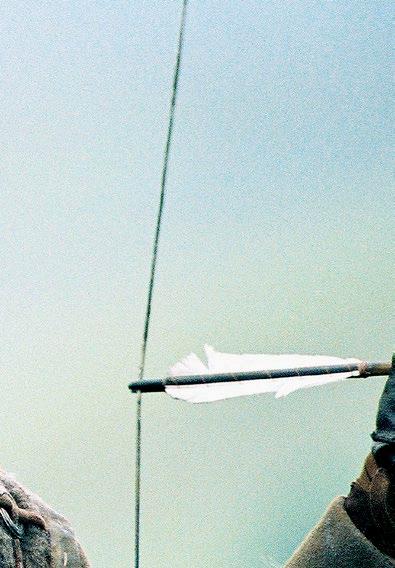
to a James Bond film, which is again very different from the Hannibal TV show. They are all villains in their own world, but they’re very, very different villains”.
He just finished work on the Fantastic Beasts… film, the Harry Potter spin-off, after he was called to take over Johnny Depp’s role of dark wizard Gellert Grindelwald, following his defamation trial. Mikkelsen has also been cast in the fifth Indiana Jones movie opposite Harrison Ford, who will reprise his

role as the intrepid archaeologist. Rumour has it Mikkelsen’s playing the… well, you can probably guess.
Despite this incredible run, this Great Dane promises he’s not looking forward to the next big thing, but simply finding “the beauty of life” in the here and now. “There is a tendency that we’re looking in the future: as long as I get this, next year will be great… then everything you do now is stepping-stones. That is not important. And you might never reach that goal. I try to live my life as if every day, every stepping-stone, is very, very important. At least if you don’t reach your goal, you’ve had some great stepping-stones.” n
Another Round opens on June 25. Riders of Justice is released on July 23



Flamboyant British TV star Laurence Llewelyn-Bowen is best known for the home improvement hit, Changing Rooms. Here, he looks back on his childhood and career
WHEN I WAS ABOUT EIGHT, I WAS DESPERATE to have a purple ceiling in my bedroom. I grew up in the Sixties and Seventies and the homes of my parents’ friends were very colourful: purple on purple; lilac on lilac; felt walls on suede, shag pile carpets, that kind of thing.
GOING BACK TO OUR HOME AND THINKING IT WAS VERY QUIET BY COMPARISON, with lots of antiques
and a 1950s vibe. The only moments of exuberance were judicious bits of moss green William Morris on the sofa or the curtains. I remember feeling the design in the space I inhabited was extremely underpowered. However, as far as my mother was concerned there was something very, very wrong with purple and she refused point blank to let me have a purple ceiling. So eventually, we settled on a






compromise and I was allowed a very pale blue one. I wonder whether I would have been a very different person if I had been allowed that purple ceiling.
FATHER’S MOTHER WAS A VERY TALENTED SEAMSTRESS and she used to make these incredible uniforms for me which I absolutely adored. There was something of the Prince Regent about me as a child and I definitely loved uniforms. I had a series of them which were all perfect. She did a complete Beau Brummell outfit for me as well which I absolutely loved,
but I would take it a bit further and used to make my own combinations: so, I could wear the trousers of one uniform, the bearskin of another and then a little bit of "Indian Brave" in between. Any sartorial interest in the dressing up box started more or less from the year dot with me.
HOLIDAYS; it was difficult when my mother was diagnosed with MS and then my father died. But when they were both still around, we would go on extended road trips around Wales looking at Edward I castles and churches. My father was incredibly

interested in heraldry. I rather loved the whole chivalry thing but for my poor brother and sister, who were very different to me and very into sport, it was the seventh circle of hell. So we would be bumping around in the back seat of my father’s rather strange fawncoloured Jaguar with no seatbelts, when the door would open and my brother and sister would be kicked out to play in a local park with some sweets—1960s Spangles probably. And then I would go on with my father and mother to find the local church or immerse myself in Beaumaris or Caernarfon.
I WAS AT CAMBERWELL (COLLEGE OF ARTS) IN THE 1980S and it was full of very serious people, which surprised me. The first day an old friend of my wife, called Fenella, was having a tricky time and I remember very naughtily telling her before the life drawing class, that she better hope the model turned up because if she didn’t, all our names would be put into a hat and the one chosen had to take their clothes off and we would draw them. And I would do all I possibly could to ensure that her name came to the top. She then became really concerned, and went rushing
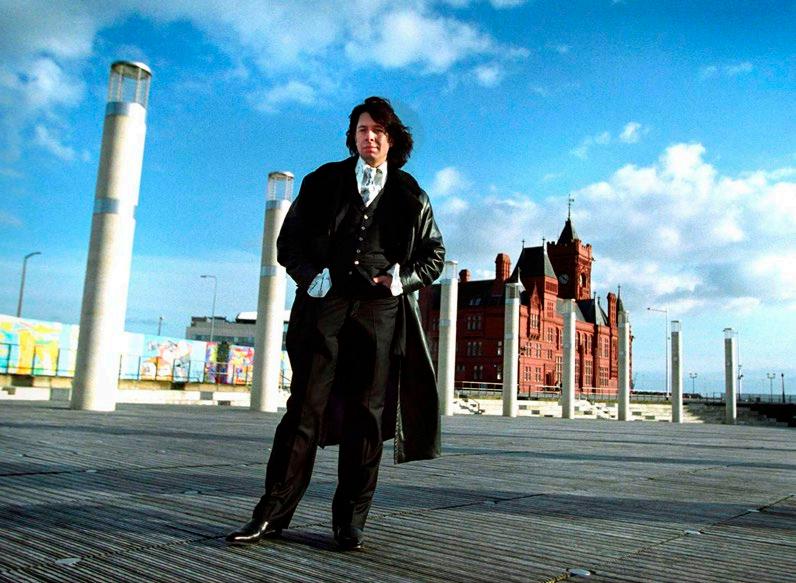
around—"Has the model turned up? Has the model turned up?!"
SITTING IN A STILL LIFE CLASS when one of the tutors came up, looked at my drawing and said, “Yes, OK, that’s coming on but you haven’t got the honesty.” I thought, Oh my God, he’s right. I’m not being honest about this. So tried to be very, very honest with my charcoal. And the whole thing was getting smudgier and smudgier. After about three or four attempts the tutor was still not happy. I was getting very frustrated and said I didn’t understand what he meant. And he said, "Oh, you haven’t
got the honesty—the flower in the corner!" I had this assumption that life at art school was going to be more artistic and deeper. That went out the window.
LONGEST
DATE. A good friend of mine was going out with a good friend of hers and I remember them saying: “Laurence should meet Jackie. They would be amazing.” I can remember this conversation going on in the background for about 18 months, but the meeting never actually happened. Then there was
Laurence in Cardiff, 2003 MICHAEL OLIVERS / ALAMY STOCK PHOTO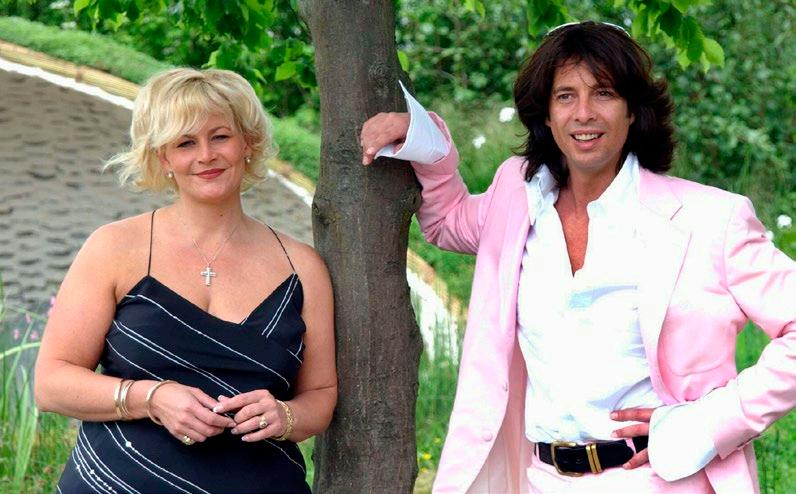
a dinnerparty to which Jackie had not actually been invited, but she lived round the corner and she rang and asked, “Do you mind if I pop over? I’m bored.” And she did, and that was it. That was the coupe de foudre in January 1984. I was 19.
JACKIE AND I WERE IN A LONGDISTANCE RELATIONSHIP FOR THE FIRST COUPLE OF YEARS. She was at the Sorbonne in Paris: her father was a diplomat and posted there and she and I used to go backwards and forwards; it was quite intense. Both of us had been very much involved in the 1980s
party, clubby scene that was going on and both of us very much needed to knuckle down and do some work. So it worked very well to have a much more tender, much slower long-distance relationship. There were no mobiles and the nearest telephone was in the metro station and very rough, so we used to write long letters to one another which always shocks the children! I think Jackie still has the letters.
THE CRITERION THEATRE WAS THE FIRST BIG INTERIOR DESIGN PROJECT I did on my own in the early 1990s. It was very high profile.
With his wife and children at the 102 Dalmations premiere, 2000

People were surprised that I did the whole theatre in pink and lilac rather than traditional reds and gold. It got a lot of attention and launched me as a “young designer to watch”. I mean, I said silly things like, “I want to turn this into a Victorian spaceship”, which everyone lapped up. But my design is still there and no one has changed it.
OUR FIRST DAUGHTER CECILE WAS INCREDIBLY TACTFUL AS A CHILD. She was very polite and slotted into our lives very elegantly.
Hermione, our second daughter, was very different. Life was much more complicated at the time, though: the paparazzi were always around; we had issues with a stalker and there were even (untrue) stories of me being gay… and Hermione was unbelievably naughty; I mean weapons-grade naughty—but in a really charming way. She once went on a play-date to a tall Georgian house in Greenwich and turned on all the bathroom taps on the top floor. The entire house became a bowl of water! That was the kind of stuff we were dealing with at the

time. I keep warning the man she is going to marry next year, but he says he can cope.
CHANGING ROOMS (THE HUGELY SUCCESSFUL BBC INTERIOR DESIGN SERIES) was a disaster for my career. It meant that my traditional portfolio of clients did not want to work with me anymore. They didn’t like the idea that the paparazzi might be following me and going through their bins, and some felt I had become a bit popularist. When the show aired, it was an immense hit. I remember the
next day being in Peter Jones (department store) and this woman thrust a piece of carpet at me and a bit of fabric and asked: “What do you think? Do you think they go together?” I said, "I am very sorry, I don’t work here," to which she replied, "I know you don’t work here but I saw you television last night.” I thought, Right, OK; that’s what it’s going to be like… n
As told to Nicola Venning
Changing Rooms will air on Channel 4 at the end of summer
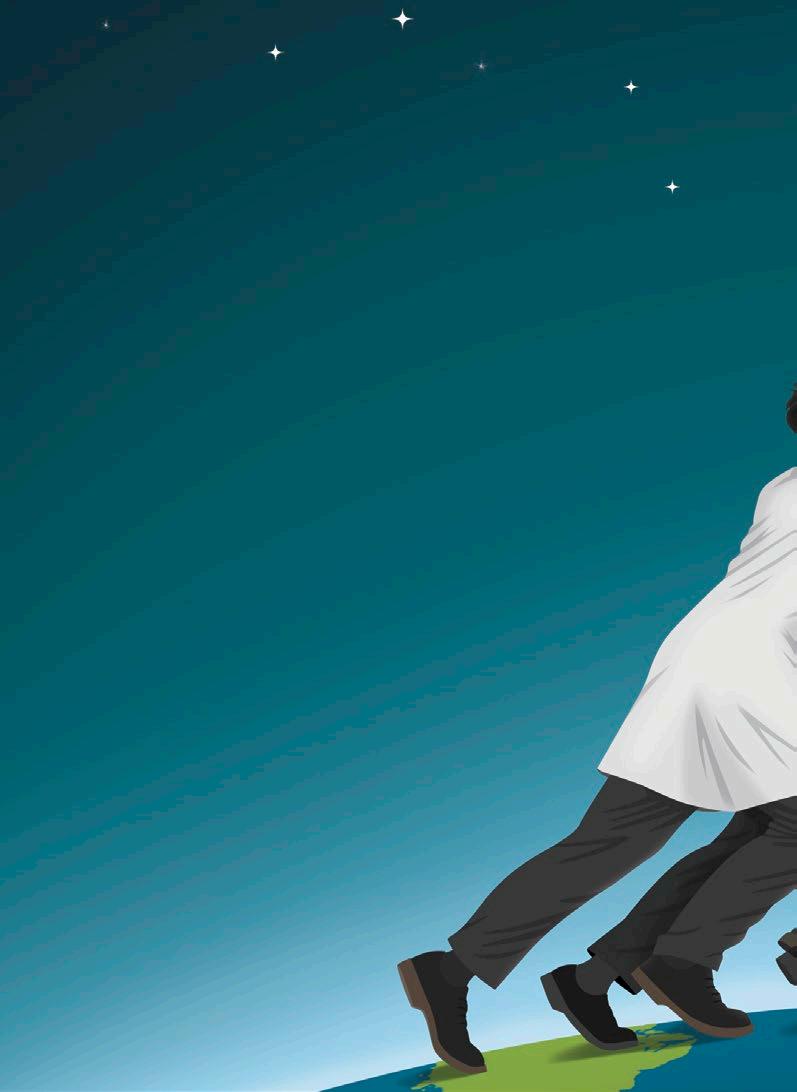
Experts the world over came together to create a vaccine in record speed. What does that mean for other health concerns?
BY Drew Turney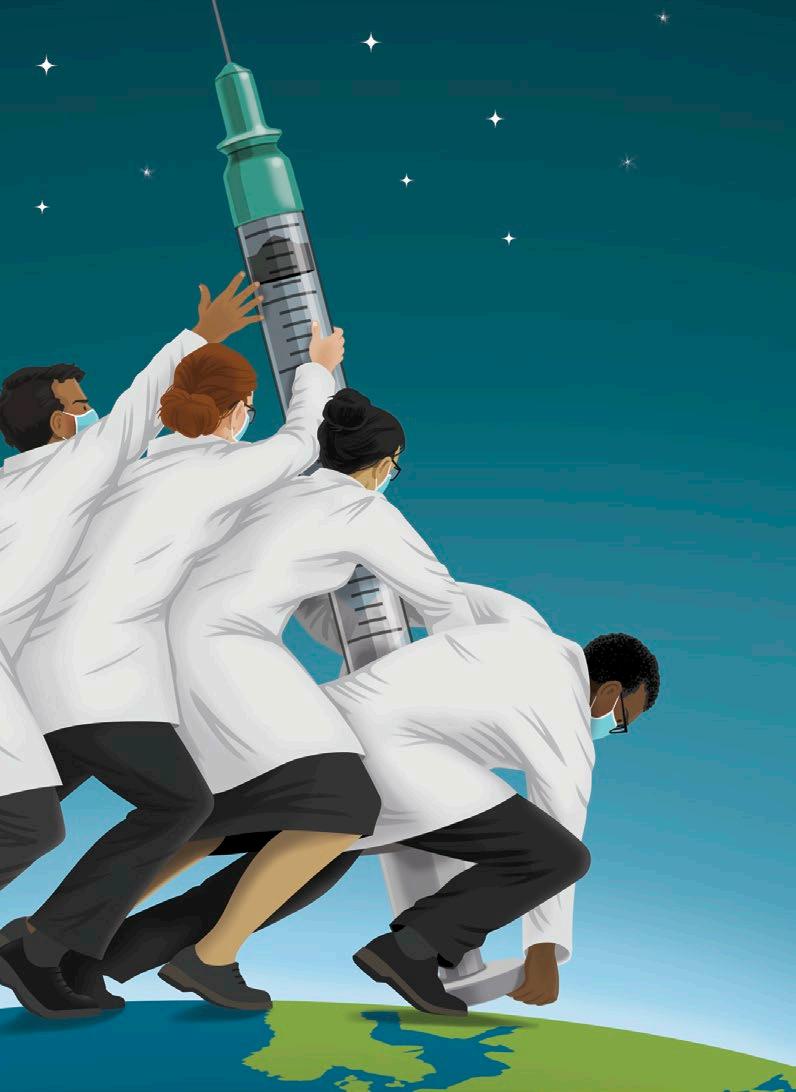
The scope and seriousness of the COVID-19 pandemic was made real to many in March 2020 when the UK went into lockdown, confining us all to our homes, and preventing social contact with friends and family. Fast forward a year or so and a vaccine has been developed, travel restrictions eased and reunions made possible for our nearest and dearest. But how did we do that so fast, when we've been living with HIV for almost half a century, battled cholera for 200 years and evolved alongside the common cold for millennia?
The answer's complicated. As Dr Kylie Quinn of the School of Health and Biomedical Sciences at Melbourne's RMIT University explains, the trick to vaccines is to look for people who've been infected and recovered. "If you can see that in the population, you can be reasonably confident you can replicate it with a vaccine."
Most people with COVID-19 have some degree of immunity after they recover, just like most of us do against chicken pox. But this isn't true for all diseases—you can catch
malaria repeatedly, and HIV attacks the very immune system designed to protect you.
Another complicating factor is that viruses—like every other life form—mutate and evolve, and some are better at it than others. The British Medical Bulletin published research in 2001 in which the genetic variation in a single patient HIV case was equal to those found in common cold cases across North America for an entire year.
So despite alarming news stories about vaccine-resistant strains, we're actually lucky. COVID-19 is a

relatively simple organism and prior research on other coronaviruses has given us a head start. Other diseases and infections are much harder to fight because we simply don't have clear targets to go after.
Still, there's no denying we got a COVID vaccine in breakneck time, and that was undoubtedly because of the resources we threw at it— £8.5bn from the US government alone. Dr Becca Flitter, a San Francisco, US-based immunologist working on vaccine development,
says that this timeline was entirely without precedent, going as far as to call it a scientific miracle.
"There was a groundswell we've never seen," Flitter says. "Suddenly scientists, clinicians and public health agencies all over the world needed to collaborate to develop vaccines as soon as possible."
As US presidential medical advisor, Dr Anthony Fauci, said in an April 10 video that the race to a vaccine was "due to an extraordinary multidisciplinary effort involving basic clinical… science that had been underway for decades out of

the spotlight." Flitter agrees, saying scientists shared data quickly not just by meeting virtually but publishing research on alternative platforms that didn't always involve the months-long peer review process.
And the sharing didn't stop there. MIT-educated biological engineer
Dr Venky Soundaraajan of Cambridge, US, says our ability to synthesise medical histories thanks to electronic health records and advances in AI is more powerful than even two years ago, revealing infection patterns and themes human eyes might not have spotted.
And governments—under
extraordinary pressure as economies and industries collapsed—were aware the usual processes wouldn't cut it. "Emergency countermeasures like vaccines can be available earlier in the regulatory process when the benefits outweigh the potential risks," says American Board of Internal Medicine certified doctor Vikram Sengupta of Austin, US, referring to America's Emergency Use Authorisation (EUA), which left the usual development and approvals timeline of five-ten years in the dust.
The why
Here's a disconcerting question—did
we devote so much to COVID-19 just because it was in the news so much? It sounds glib, but several of the scientists we talked to said interest in immunology and vaccines suddenly skyrocketed. It's easy to imagine a scientist working with Parkinson's or heart disease grumbling that they could have done with just a little of that money and attention.
"Before the pandemic there was limited funding or interest in vaccine development," Flitter says, adding that for better or worse, drug development and healthcare are free-market activities. "[Many other diseases] deserve attention, but few other illnesses suddenly crippled public health or imposed such economic hardship like COVID did."
Says Kate Elder, Senior Vaccines Policy Advisor, Médecins Sans Frontières, London,"[COVID-19] posed the greatest threat to highincome countries in the beginning, so they really moved money and science to respond to it."
A cynic might also suppose that the pharmaceutical industry, after the billions of pounds and years of research that goes into drug development, just isn't interested in cures that don't give stockholders a decent return.
"Sadly it's all too obvious those diseases aren't on the home front of the wealthy countries that hold the purse strings," says Elder, "they're not as motivated to address them and
they become the responsibility of a handful of small health organisations that don't have the resourcing we've seen with COVID."
According to immunologist and biologist Dr Jyotsna Shah of Milpitas, US, every disease would get the same focus as COVID in a perfect world, but there are only so many resources from governments and private industry, and most of those will go to diseases with the highest fatality rate or profit potential.
"The National Institutes of Health
BEFORE THE PANDEMIC THERE WAS LIMITED FUNDING OR INTEREST IN VACCINE DEVELOPMENT
and the CDC spend just $90 and $35 per new case of Lyme disease respectively, compared to $53,571 and $14,054 on each new case of HIV/AIDS." But in physician William Li's experience as an independent expert who's consulted on drug development, people working in biotech and pharmaceuticals are passionate in their quest to find effective disease treatments. "There's no conspiracy," he says, "[drug development is] just a really hard and long road."
Pharmaceutical research is tied up in IP rights, territorial licenses and pricing models—a situation even an industry source (who wished to remain anoymous) called "a big mess".
Might the way we came together to tackle this crisis change that, paving the way for better-resourced disease research? Dr Bob Bollinger, Professor of Infectious Diseases at Baltimore, Johns Hopkins University's School of Medicine, says it's possible, particularly for public research.
WE'VE LEARNED A LOT ABOUT COVID VACCINES AS POTENTIAL TREATMENTS FOR OTHER DISEASES
"Such fast development of tests and vaccines are a clear example of the collaboration between scientists and the importance of public investment," he says. "Many of the scientists who made critical discoveries worked at universities and public agencies."
Better yet—and back to the notion of responding to news cycles rather than health crises—we shouldn't forget the advances in other fields even if there have been no grand announcements of cures.
"We have two vaccines that prevent cancer and oral medications that can cure hepatitis C, one of the biggest causes of liver cancer. New classes of diabetes medications help reduce coronary vascular disease complications and reduce total mortality," says family medicine physician Dr Puja Uppal of Michigan. "These are all really huge accomplishments!"
It should also be kept in mind not just how much work led us here before the pandemic, but where the work on COVID might take us. Because years of study were so compressed, we've learned a lot about COVID vaccines as potential treatments for other diseases— everything from Ebola and Zika to influenza and cancer. "It's the silver lining of the COVID pandemic," according to Shah.
Soundaraajan goes further. "Two years from now the innovations in COVID, telemedicine and the AI revolution would have disrupted every conceivable field in medicine."
So back to the original question—if we spend enough and put enough public and private experts together, can we cure anything? Eric Rubin, editor in chief of The New England Journal of Medicine is cautiously optimistic and circumspect in equal measure. "There are very few examples where the kinds of resources have been put into the development of vaccines… like in the

current outbreak. Even though many diseases just aren't amenable to straightforward approaches, it's likely if we spent billions on each one we might have some breakthroughs."
Elder hopes those of us in rich countries take the global interconnectedness COVID-19 has revealed to heart—that our health is dependent on others. "It's become a sort of adage that nobody is safe until everybody is."
And as science and technology enthusiasts have long lamented, the age of exploration that let us sail around the world, unlock the secrets of nature and put man on the moon seems long gone.
Maybe COVID has reminded us that—when faced with the imperative—we still have the spirit to come together and solve grand, society-spanning problems.
Can we do it again? n
Fashion designer Donatella Versace once flew the boyband Blue out to Milan Fashion Week in her private jet as her guests of honour, thinking that she had invited the Brit Pop band Blur

Sunny days are here again, making this the perfect season to try some cheap, simple, open-air strategies to boost your health and wellbeing
1. Grow your own
Even if you’re not a keen gardener, it’s easy to grow a few veg from seed. It will save you money, yield some healthy produce and leave you feeling deeply satisfied. Digging is a great exercise, giving your body a workout and burning off calories.
Short of space? Radishes, salad leaves, carrots and dwarf French beans all grow well in pots and can still be sown in July.
2. Welcome the weeds
Of course, no garden, however idyllic, is spared these evil plants. But instead of blasting them with eco-unfriendly weedkiller, learn to love removing weeds by hand. Not only is it good exercise but it can be
very meditative. Studies have shown that spending time in your garden is beneficial to health, with advantages ranging from improved quality of life to reducing anxiety.
No garden? All is not lost. There are community gardening projects all over the country. There’s a search facility on the Royal Horticultural Society website, www.rhs.org.uk.
3. Gather some wildflowers
Whether you live in the countryside or simply within reach of a green space or uncultivated patch of ground, pick a small bunch of wildflowers for an instant pickme-up. It’s a great reason to go out for a walk and it won’t cost a thing. But be careful not to uproot plants or take flowers from private land.
4. See the sun rise
Getting up early to see the sun come up will give you a wonderful feeling of calm and appreciation of the things that are bigger than us all. It may also help reset your body clock.
Not good at getting up early? You can just grab a cocktail and watch the sunset instead.
5. Get lost in a book on the beach
Borrow a book from a friend or the library and read outside, whether that’s by the sea, in a park or on your patio. A study from the State University of New York College of Optometry found that the light
outdoors improved contrast when perusing printed pages, making them easier to read. What’s more, research has found that reading can help you live longer and stave off cognitive decline.
6. Take a dip in the sea
Being in or near water is a great stress reliever. Swimming is also easy on your joints, and builds muscle strength and cardiovascular fitness.
Nowhere near a beach? Wild swimming in lakes and rivers is becoming increasingly popular. Lidos are making a comeback too.
7. Become a birdwatcher
Another cheep (sorry!) and cheerful way to get a happiness fix is to spend time spotting our feathered friends. Academics from Exeter University, the British Trust for Ornithology and the University of Queensland, Australia, found that watching birds in your neighbourhood was linked with lower rates of anxiety, stress and depression. n
For more weekly health tips and stories, sign up to our newsletter at readersdigest.co.uk

Susannah Hickling is twice winner of the Guild of Health Writers Best Consumer Magazine Health Feature
Foot odour is common and it’s embarrassing. But there are ways you can minimise its whiffy impact
What causes smelly feet?
It might surprise you to discover that the number one cause of humming hooves—or bromodosis, to give the condition its medical term—is your shoes. Wearing the same footwear day in day out, or shoes that are too tight, or which don’t let your feet breathe enough, can all be to blame. Being on your feet all day and being prone to excessive sweating—hyperhidrosis— don’t help either. Stress can make your feet sweat more, while foot problems like athlete’s foot, calluses and corns also cause a bad smell. Essentially, bacteria and sweat come together in enclosed footwear to create stinky feet.
Tackle bacteria by soaking your feet in a mix of white or apple cider vinegar and water every night (opt for two parts water to one part vinegar). This makes your skin less attractive to them. Tea tree oil or surgical spirit applied between your toes at bedtime will also help kill bugs. Pick up an antibacterial soap at your local pharmacy. A moneysaving tip: did you know that you can use an ordinary underarm deodorant or antiperspirant on your feet?
Treat corns, calluses and fungal infections like athlete’s foot with over-the-counter ointments, though people with diabetes should see a podiatrist or GP.

What about footwear?
Don’t wear the same shoes every day— alternate so that they have a chance to dry out. Make sure shoes have canvas or leather uppers (and are preferably also lined with leather) to allow your feet to breathe, and keep them in a cool place to discourage bacteria from proliferating.
What are the best treatments?
Washing your feet at least once a day and then drying them properly, including between your toes, is key.
Always wear socks with enclosed shoes. Those should be made of natural fibres such as wool or cotton, but you can also get special sports and antibacterial socks designed to keep your trotters dry. Special medicated insoles will help deodorise them. n
Sammy Margo is a chartered physiotherapist with a private practice in north and north-west London
What led to you becoming an expert on exercise and sport, including running? I qualified as a physiotherapist in 1988. I have worked in professional football and skiing as well as the NHS. I set up my own practice about 25 years ago and look after the whole range of people from marathon spectators to elite athletes.
Why is running a good exercise?
Running can work multiple body parts all at the same time. It can improve posture, aerobic fitness, bone density and muscle mass. By doing that it can contribute to your longevity. Running also has cognitive benefits. Studies say it can decrease stress, increase productivity and help with the release of your happy hormones—endorphins—giving you a healthier, more positive outlook.
How should older people start?
A really good rule is to do things gradually. You could begin by walking, progressing to fast walking, moving on to hill walking and then to walking interspersed with running. Start by doing a shorter distance and then increase distance and pace. Using

apps like Couch to 5K which guide you through the incremental increase is something we recommend.
What are the best ways to remain injury free?
Stretching, strengthening and gradual build-up are fundamental. You need to have decent running shoes and think about appropriate warm-up, making sure you’re not overdoing it. Remain consistent— have a running routine.
What ‘s the most common running injury and how should people deal with it?
Runners’ knees is probably the most common one. It’s like a repetitive strain injury. Use RICE—rest, ice, compression, elevation—in the short term. If it’s not working seek out the advice of a chartered physiotherapist. You might need to come off running and gradually go back on. In the meantime, do another sport that isn’t as stressful on your knee to keep yourself going. n
For more information go to www.sammymargophysiotherapy.com
The nation’s “obesity crisis” has Dr Max feeling nostalgic

“I
n the good old days.” If ever there was a phrase to provoke a collective rolling of eyes in the younger generation it’s this. Roundly speaking, I’m never convinced the good old days were that good. I only have to listen to my gran talking about the constant fear of polio, doing laundry by hand and having entire meals consisting of dripping on bread to be thankful that I’m alive now, and not then. Of course, precisely when the good old days were, is very

Max is a hospital doctor, author and columnist. He currently works full time in mental health for the NHS. His new book, The Marvellous Adventure of Being Human, is out now
subjective. I was recently rather horrified to overhear my teenage cousin refer to the 1980s as being “the olden days”, when I can remember large tracts of it with crystal clarity. But, the further back in time one goes, it is clear that things do change and different eras are associated with different mentalities, attitudes and mores.
I certainly think that, overall, we have progressed and society has advanced in many ways since my gran was my age. However, while no sane person really wants to go back to the inequality and hardships of the 1950s and 60s, having just finished a week of nights in A&E, I have come round to the idea that we, as a nation, are in need of a bit of old-fashioned stoicism. It is obvious that while technological, social and medical advances have shaped and altered our lives, a significant shift in recent years has been our understanding of responsibility, ownership and human
agency. This is particularly evident in the contentious area of obesity. Why is it that we have seen the rate of obesity rise from around 1-2 per cent of the population in the 1960s to 28 per cent now? A simple answer would be lifestyle. A fascinating survey recently conducted by the Department of Health compared data collected from 1967 and 2010. It showed that while people in the 1960s were slimmer than they are now this was despite fewer gyms being available and them eating high-fat foods. As you would expect, the difference in obesity rates was attributed to the fact that they exercised more compared to our relatively sedentary lives. Only three out of ten households had a car then, compared to seven out of ten now and while 75 per cent of people walked for at least half an hour a day in the 1960s, this is only about 40 per cent now. But what really stands out, more than the lifestyle differences, is the sharp contrast in the attitudes towards obesity between the two different eras. The 1967 survey found that nine out of ten people had attempted to lose weight in the past year compared with 57 per cent of adults questioned in 2010. Perhaps most tellingly though, 40 years ago only seven per cent of those
people who considered themselves overweight had failed to do anything about it, compared with over 40 per cent now. So while it would be easy to attribute the rise in obesity to lifestyle changes, actually, a large part of this is that people just aren’t bothering to lose weight any more.
This may be partly down to the fact that as more people are overweight, so it is viewed as increasingly normal and therefore not worthy of change. But I also think that it’s down to the attitude that I witness frequently in A&E— that things aren’t the problem of the individual and we refuse to take responsibility for our own behaviours. Let’s blame obesity on the government, on the food manufacturers, on our genes. Let’s demand fatloss pills on the NHS and stomach-stapling surgery as a right. As any dietician will tell you, trying to impress on patients that eating less and exercising more is the answer to obesity is hugely unpopular because it involves hard work and taking responsibility. Is it any surprise obesity has risen over the past 40 years if more people know that they are overweight but choose not to do anything about it?
In the good old days, we were not only slimmer, but our attitudes to obesity were healthier to o. n
Q: Dear Dr Max, I seem to have become more prone to carsickness as I have grown older, and I can’t do anything when I’m a passenger except sit and look out the front, and even then I feel like I will be sick. I am worried that it will start to affect me as a driver too.
- Charles, 68A: Thanks for your question, Charles— I’m sure there are a lot of readers who can sympathise with you because, actually, it’s surprisingly common for this to come on as people age.
Car sickness is really a form of motion sickness. This is caused by repeated movements when travelling or moving about. Our brains detect movement thanks to cleverly designed apparatus in our ears called the semi-circular canals. These are fluid filled tubes and as we move our head, the fluid moves against the tiny hairs lining the tube and this sends a message to our brain which, combined with information from our muscles, eyes and joints helps it calculate where we are in space and detect movement. When it
receives conflicting information, then it gets confused, doesn’t know if we’re stationary or moving and this causes us to feel sick. We often think of car sickness as affecting children but they are only one group who seem to be susceptible—pregnant women, those with a history of migraine and older people are all more at risk of developing it. No one knows for sure why it can come on as people age but it’s likely to be a combination of factors and we do know that some people just seem to be genetically susceptible to experiencing it compared to others.
While there’s no cure, there are medications and remedies that can help—if you experience motion sickness speak to your local pharmacy and see what they recommend. People tend to find their symptoms are better if they sit in the front and look at the horizon. Avoid reading in the car and get plenty of fresh air. Drink lots of water and avoid heavy meals before travelling. n

Got a health question for our resident doctor? Email it confidentially to askdrmax@ readersdigest.co.uk










Switch on all your senses and you’ll soon sharpen your recall, says our memory expert, Jonathan Hancock
Like many families, the best thing to come out of the pandemic for us has been a puppy. Enzo the Cavapoo may have caused his fair share of mischief, but he’s also added a great deal of fun to our lives. And I’ve found him fascinating not least because he’s taught me some important things about memory.
For Enzo, seeing is just one way to investigate the world—and not even the most important. His nose is much better for finding out about something new, and he also uses his tongue, his paws, and his ridiculously floppy ears to engage with everyone and everything around him. His world is a seething mass of senses, and he uses them all to explore and learn.
I think we all need to be a bit more like Enzo! In a way, it means going backwards—to when we were babies, and it came naturally to learn through all our senses. That kind of multidimensional approach activates much more of our brainpower, and it can make a huge difference to how
much we are able to recall.
To prove it, try this quick experiment. First, read through List A.
List A: guitar, apple, clock, kitten, balloon, walnut, sock, toaster, needle, soap, radio, flower.
Close the page, and do something else for a minute or two, before seeing how many of those 12 items you can still remember.
After that, turn to List B. This time, as you look at each word, think of another sense to go with it: an appropriate smell, sound, texture or taste. For a moment, imagine you’re experiencing that particular sense.
List B: snake, cheese, violin, candle, TV, coal, alarm, bath, ice cream, towel, garlic, baby.
Then distract yourself for a couple of minutes, before testing yourself to see how much of this second list you can recall. I’ll bet that it’s considerably more than you managed from List A!
Senses strengthen memories. So think about tastes and smells when you’re making a mental note of what to buy at the supermarket. If you meet an interesting new word, focus on what it sounds like as well as how it looks. When you hear someone’s name, picture whatever it reminds you of.
Start engaging with information by using more than just your eyes. But keep watching your pets—and your little people—for tips on multidimensional memory, because they certainly know it makes sense! n


“I trust Wellman for my health and have relied on it for years”


Veteran BBC foreign correspondent for over 30 years & former independent MP ‘The man in the white suit’, age 82 years


SCIENCE OF HEALTHY AGEINGTM
30 nutrients

To help maintain health & vitality
With zinc to help maintain normal vision, immune & cognitive function





LIFE CARE FOR A LIFETIME TM







From , Superdrug, Holland & Barrett, supermarkets, health stores, pharmacies & WELLMAN.CO.UK
*UK’s No.1 men’s supplement brand. †Nielsen GB ScanTrack Total Coverage Value & Unit Retail Sales 52 w/e 30/01/21. To verify contact Vitabiotics Ltd, 1 Apsley Way, London NW2 7HF.



A guide to 13 symptons you should never ignore
 BY Mark Witten
BY Mark Witten
tephen Chow knew something was off when he started making more spelling errors in his work emails. This was in 2010, and Chow, 51 at the time, was an IT specialist living in Scarborough.
He tried to ignore the mistakes at first, but the situation became more obvious when attempts to punch in his password kept failing. He found it gradually harder to focus and perform simple, familiar tasks, such as calculating numbers or putting his signature on a document. “Everything was all messed up, and I didn’t know what to do about it,” he says. Not wanting his wife, Eva, and two adult sons to worry, he kept it a secret, hoping he could just muddle through.
Instead, over the next several years, more alarming symptoms appeared. As Chow made the daily 90-minute drive to and from work, he had trouble seeing the centre line on the road, as well as the cars beside him. In early 2014, his patchy vision almost killed him when he couldn’t clearly discern the road’s edge and slid into
the ditch during a snowstorm. He was unharmed, but his anxiety mounted, and he decided to talk to his doctor.
When Chow described his difficulties with typing and driving— both related to motor skills—his physician initially referred him to a specialist in Parkinson’s disease. That condition was ruled out because he didn’t have hand or leg tremors. In May of 2014, Chow had an appointment with Dr Carmela Tartaglia, a cognitive neurologist specialising in early-onset dementia.
Tartaglia suspected Chow’s symptoms were visual-spatial processing problems, a warning sign of Alzheimer’s disease—and she noted one subtle but telltale clue.
“Stephen’s writing difficulties became more apparent in Cantonese,” she says. “It’s his first language, and Cantonese is a more visual language than English.”
Weeks later, an MRI showed a shrinkage of cortical tissue in the back of his brain—the region involved in processing what and how we see— and biomarkers identified in his cerebrospinal fluid 18 months later finally confirmed, six years after Chow first noticed his symptoms, that he had early-onset Alzheimer’s disease.
Chow is one of about 50 million people worldwide living with dementia. Although the rate of people who develop dementia has been declining for decades due to healthier
lifestyles, the total number is still projected to double over the next 15 years because of the ageing population. Each year, more than 10 million people are diagnosed with some form of dementia. In the UK, 42,000 people aged under 65 have dementia.
Early detection of dementia is important so that the person diagnosed, and their family members, can take steps to slow and mitigate the effects of the disease through lifestyle changes. Ideally, that would mean undergoing specialised testing and receiving a formal diagnosis within six months or a year after noticing symptoms. But according to an Australian study, on average, it took two years for people to make an initial visit to a doctor and over three years for a firm diagnosis. People often associate dementia with memory loss, but in many cases this is not the first sign. In fact, dementia can affect many different areas of the brain, and scientists now understand that symptoms differ based on where in the brain changes occur. With this knowledge, doctors now use advanced tools, such as brain scans and protein biomarkers, to make earlier, more specific dementia diagnoses.
But getting to that stage requires noticing that something is wrong— and letting somebody know.
“The first time I knew Steve had a problem was when he called me from Dr Tartaglia’s office,” says Eva. Once the diagnosis was made, she realised
there had been indications. She just wasn’t aware of what to look for.
Here are 13 signs that you should be assessed for dementia:
Inappropriate behaviour is an early symptom of damage to the brain’s frontal lobes, which regulate our social judgement. “People with this dysfunction might undress in public, talk about people’s private parts or say, ‘That person is stupid,’” explains Dr Robin Hsiung, neurologist and associate professor at the UBC Hospital Clinic for Alzheimer Disease and Related Disorders. “They lose social graces and forget that what they’re saying or doing isn’t right.”
These symptoms are often seen in frontotemporal dementia (FTD), but also when Alzheimer’s or vascular dementia affect the frontal lobes. If they’re not recognised, they can be particularly unsettling. “The worst symptoms for families to deal with are when there is a personality shift and the person becomes increasingly agitated or even paranoid and suspicious,” says Carrie Bourassa, a professor at the University of Saskatchewan’s college of medicine in Canada who specialises in dementia and ageing in Indigenous populations. Unusual behaviour can sometimes be confused with psychiatric conditions, such as bipolar disorder or
schizophrenia. Brain imaging can rule out or support a diagnosis of dementia.
Recurring visual hallucinations may be an early symptom of Lewy body or Parkinson’s disease dementia, although people with Alzheimer’s disease can experience them, too. These can be as simple as seeing flashing lights or as elaborate as encountering animals and people that aren’t real.
“Sometimes the hallucinations are quite frightening, like seeing a wolf or a bear trying to break through the window,” says Hsiung. “Other times

they’re more positive, like a grandmother who looks out the window and sees her grandchildren playing in the playground, when no one is there.”
Researchers believe that visual hallucinations may be caused by damage to the brain’s visualprocessing system, in combination with the disease’s disruption of the sleep cycle—so that the visions might actually be dreams breaking into waking consciousness.
Word-finding difficulties are a common early sign of dementia. You might have trouble finding the right words during conversations or when naming objects, sometimes substituting the wrong word. People affected in this way pause while speaking, use filler words and frequently rely on “it” or “they” instead of specific names for things. Researchers have found that these word-finding problems increase significantly in the span of just two years for people developing dementia. Language can, in fact, be affected before memory problems emerge. An Arizona State University study analysed former US President Ronald Reagan’s press conferences and found speech changes more than a decade before he was diagnosed with Alzheimer’s. To assess whether your
word-finding challenges are related to a shrinkage in the language areas of your brain, pay attention to when and how often this happens. It could simply be a result of being tired or stressed—and can be caused by anxiety, depression, stroke and delirium, as well.
Problems with spatial awareness can be caused by cataracts or glaucoma, but they’re also an early sign of dementia. This was the case with Chow, whose first Alzheimer’s symptoms were caused by a shrinkage of the area of the brain crucial to his ability to accurately perceive the world three-dimensionally.
“A patient with posterior cortical atrophy may see the world in a patchy visual field,” explains Hsiung. “If the person is focusing in front while driving, he can’t see things off to the side. And if he’s changing lanes, he can’t see other cars beside him.” Meanwhile, when Chow made mistakes typing, he was having trouble seeing the whole keyboard.
In addition to visual-spatial processing issues, Chow also had trouble with concentration due to shrinkage in his frontal lobe. “That made writing, reading and driving
difficult and affected his ability to do high-level tasks as an IT specialist,” says Tartaglia. Beyond Alzheimer’s, any other kind of dementia can affect this area of the brain—but an inability to focus can also be caused by anxiety, depression or medication side effects.
It’s not unusual to occasionally forget where you stashed your keys. But if you’re doing this regularly, leaving the hob on or frequently forgetting recent events and conversations, this could be a warning sign. Commonly, says Hsiung, people with this type of memory loss will ask loved ones the same questions over and over again.
“Families can help a lot in recognising early symptoms, because if the person’s memory is poor, they won’t remember the problems they have in remembering,” he says.
This sign often points to Alzheimer’s. In this type of dementia, the hippocampus—the brain area involved in forming, storing and retrieving memories—may be affected first. In fact, short-term memory loss is the most common symptom among people with Alzheimer’s disease, whereas it’s less often an early sign in vascular dementia and Lewy body dementia, and rarely in FTD.
Medications and depression can also affect memory, so it’s important to check in with your doctor.
A pattern of uncharacteristically poor financial decisions should set off alarm bells. “When you have frontal-lobe damage, you lose judgment and can make rash, impulsive financial decisions,” says Tartaglia. “A frugal person starts giving away more money or buying things they don’t need—like a furnace from a door-to-door salesperson.” She’s seen patients who did significant damage to their families’ finances, as well as CEOs of companies who lost millions because nobody noticed the signs.
A combination of declining decision-making skills and memory can also lead to financial lapses. A 2020 JAMA Internal Medicine study found that people with dementia started missing bill payments up to six years before they were diagnosed.
According to a University of Cambridge study, a lack of interest or motivation can predict the onset of dementia many years before other cognitive symptoms do, especially in people with FTD, who may be diagnosed as early as age 45.
Hsiung cautions, however, that apathy can sometimes be confused with depression, as the difference between them is subtle; a psychiatric
assessment is often required to tell them apart. “In both, a person may sit on the sofa all day long,” he says, explaining that the key difference is how much their mood ranges.
If someone becomes tearful when they hear a sad story, this could be a sign of depression, but it’s apathy if the person shows no emotional response. If it’s the latter, Hsiung says, then it could be the beginning of Alzheimer’s disease, FTD or vascular dementia.
Difficulties with movement and performing physical activities in the right sequence can be an early sign of damage to the parietal lobe, which is related to motor skills—and this is one of the signs that Eva thinks she overlooked in her husband. Three years before his diagnosis, the couple began to participate in dragon-boat racing. Chow had always been a wellcoordinated athlete and handyman, but during training he struggled to learn the basic stroke technique. “The coach kept telling him, ‘This is the way you do it.’ Steve didn’t get it very well, and he was upset with the coach,” says Eva.
Motor problems are also common with Lewy body dementia, but other neurodegenerative conditions, such as Parkinson’s and multiple sclerosis, should be considered, as well.
According to a 2016 Neuroscience Research Australia report, loss of empathy is a core symptom in some people diagnosed with FTD. It’s related to loss of grey matter in the social brain. These patients are unaware of the impact of their behaviour on others, and they lose both the ability to understand other people’s emotions and to share in their feelings. “You may not care about your family anymore,” says Tartaglia. “Or a family member is crying, but you don’t recognise that they are sad.”
Problems with tasks that require abstract thinking, are an early symptom that can be caused by damage in the frontal and parietal lobes. For Chow, this appeared early at work in his inability to make simple calculations, but it also impeded his long-held role as the manager of his family’s finances.
Mood changes, such as depression and anxiety, can be early signs of dementia well before people begin to experience memory loss, according to a 2015 Neurology study. Tartaglia notes that, especially with Lewy body
dementia, non-anxious people can become anxious much of the time. They may exhibit persistent worry, fear or agitation, commonly triggered by going outside the home.
Losing navigational skills, and the ability to create a mental map of your environment, can be one of the earliest dementia symptoms. In fact, in 2019, University of Cambridge researchers developed a virtualreality navigation test that has proven to be better at identifying early Alzheimer’s disease than FDAapproved neuropsychological tests currently considered to be a gold standard for early diagnosis.
onCe Chow was diagnosed, his anxiety about his symptoms decreased and he became calmer. “Eva is the model caregiver because she wants to do what’s best for Stephen and encourages him to do things,” says Tartaglia. This has included joining support groups, daily meditation and regular exercise. But perhaps most importantly, with Eva’s encouragement, Chow began to share his diagnosis with the people in his life. “I felt better after I told family and friends,” he says. “They were very supportive, and it took a load off my shoulders. I learned that you should tell people what you’re noticing sooner rather than later and not keep it to yourself.” n


Rather than one specific disease, dementia describes a group of symptoms that are caused by disorders affecting the brain. There are more than a dozen types of dementia, including rare conditions and others that may develop from other brain disorders, like Parkinson’s disease or Huntington’s disease. Here are the five most commonly diagnosed forms of dementia:
Alzheimer’s disease is the most common type of dementia, accounting for up to 80 per cent of all diagnoses. Alzheimer’s affects most areas of the brain and can therefore involve changes in memory, language, problem solving, mood and behaviour.
Vascular dementia, the second-mostcommon type, happens when there is
a blockage to the brain’s blood supply, which causes brain cells to be deprived of oxygen and die. Strokes, transient ischemic attacks and blood-vessel disease are common causes of vascular dementia and can affect different brain areas.
Lewy body dementia is caused by abnormal deposits of a protein called alpha-synuclein inside the brain’s nerve cells. This protein, which destroys brain cells, is also found in people with Parkinson’s disease. Areas of the brain involved in thinking, movement and visual processing are most affected.
Frontotemporal dementia mainly affects the frontal and temporal brain areas and accounts for about 20 per cent of cases of early-onset dementia. Changes in personality and behaviour are more apparent in the early stage, while memory decline often doesn’t occur until later.
Mixed dementia occurs when a person has at least two different types of dementia at once, most often Alzheimer’s disease and vascular dementia. Studies reveal it’s much more common than previously thought.

“All the serious bands, all the punks, came from Bristol”
- Roland Orzabal of Tears For Fears

Alright my lover? At the heart of the West Country, the city of Bristol is known for its outgoing, friendly residents, vibrant music and food scene and, of course, its most famous son—the anonymous but prolific graffiti artist Banksy.
The name of the city derives from the Old English Brycgstow, which means "place at the bridge", and suitably enough, today the Clifton Suspension Bridge is one of the city's best known landmarks, providing a spectacular backdrop for the annual Bristol International Balloon Fiesta, in which hundreds of hot air balloons from around the world take off across the city.
Bristol is also known as a media hub and is home to the BBC Natural History Unit, producing such beloved shows as David Attenborough's Life On Earth, Blue Planet and Planet Earth. Aardman Animations—the studio behind Wallace and Gromit and Shaun the Sheep—are also based out of Bristol, making the city a must-visit for stop-animation fans.
Known as the "Godfather of graffiti" and Banksy's mentor, John Nation narrates a new self-guided tour as part of Where the Wall for the ultimate COVID-secure street art experience, accessed by smart phone. Visit wherethewall.com

What do I love about Bristol? Where do I begin? There are so many reasons. Firstly the people. It's cosmopolitan, multicultural, vibrant, free-spirited, full of rich history, great architecture, diverse art and it's very political. I love the Bristolian accent too.
Banksy, the world famous artist who hails from the city once painted over an official traffic sign on the M32 as you approach the outskirts of the city with the words: "Welcome to the West Country, Please don't laugh at our accent."
We sound like farmers to many, but
it's just another part of Bristol that makes me smile.
People ask, "What does it mean to be Bristolian?" Well, that depends on the individual you ask. For me, it's a sense of pride coming from this city. I'm a born and bred Bristol lad. It's in my heart and soul. The Bristolian spirit is one of free-thinking, about knowing right from wrong, about fairness, humility and equality.
Bristol has become internationally recognised as a city known for its great street art and graffiti. It's important not to confuse the two—Bristol has had a well-respected graffiti scene since the


1980s, well before street art was even a thing. They are two separate cultures. Then, of course, you have the Banksy factor and the globally recognised artist that he is.
We have four decades of history—the artists, the Vanguard, alternative culture and contemporary art that make this city one of the most vibrant and colourful in the world.
Obviously graffiti is not to everyone's liking in the city, but there's no denying that it has had a huge impact in shaping the city's identity both at home and internationally. That's why I'm a street art tour guide for Where the Wall. I love to walk the painted streets of Bristol and share my passion and knowledge with visitors to the city from around the world. It's my dream job.
People always ask me what my favourite piece of art in the city is. It's such a hard question for me to answer because there's just so much great diverse art in the city. But if I had to choose just one piece, then it would have to be the iconic Banksy piece, The Mild Mild West
This piece was painted in 1999 in the Stokes Croft area and is the final piece that I show at the end of the guided graffiti tour.
Why this one? For me, The Mild Mild West is Banksy's signature piece. It's like an alternative greeting,"You are now in Bristol, The West Country". For me it has everything and it's probably the most known and photographed work of Banksy's in the city. It is iconic.
Briony May Williams is a baker and TV presenter born and raised in Bristol. In 2018 she appeared on Channel 4's much loved baking contest, The Great British Bake Off

I am a born and bred Bristolian and I am very proud of that fact! I grew up here and decided to settle in Bristol after moving away for my university years. Bristol is my home and I love it so much. All my family are here and lots of my friends. It’s a wonderful place to bring up a family, as there is so much to see and do here.
There's so much that I adore about Bristol. I love how friendly everybody is here, and the city itself is so beautiful from the architecture to the green spaces. We
also have an amazing food scene, which my family and I love to explore. Bristol has a wonderful vibe to it and I can see why people come here and never leave!
In the time that I've lived in Bristol, I think that the city has expanded in all the best ways. We have so many more amazing restaurants, pubs, bars and cafes now, for example. Over the years, Bristol has maintained its stellar reputation for supporting independent businesses which I think says a lot about the city and the people here. The shopping, the food, the open spaces… I think everything has improved over time. It has been amazing to witness how Bristol has grown and flourished while still feeling like a closeknit place and community.
For me, being a Bristolian is about being down to earth, friendly and always up for a chat! The Bristolian spirit is warm and welcoming; all my friends who come to visit me here remark upon how nice and friendly Bristolian people are, and I couldn't agree more.
When I appeared on The Great British Bake Off [Briony reached the semi-finals of the Channel 4 baking competition in 2018] I felt so much love from my fellow Bristolians! People would stop me in the street and say how proud they were of me and how I was representing Bristol really well. I was then and remain so grateful for the support from Bristol, it meant the world to me. n
To plan a future visit to Bristol, head to visitbristol.co.uk





Jimmy Brown is the cofounder and drummer of the legendary reggae band, UB40. Their new album Bigga Baggariddim is released through SRG Records on June 25

I would implement a generous universal basic income—not just a subsistence wage, but something that can actually help people to thrive rather than survive. I think the establishment still has that mentality that poor people would just not bother to work if they had a basic income—as if they need to be punished to work, whereas rich people need to be given more money and pay less tax for them to work better. There’s a eugenics
divide in the classes, and I would just make basic income available across the board to everybody.
I would take decision-making away from the centre and push it locally as far as possible. Towns, and areas and streets inside those towns could make their own decisions that affect them personally in their own environment—I would divide it between the smallest units possible. Breaking down the centres of power,
that one per cent consisting of just a handful of billionaires is extremely important, in my opinion.
We’d work to live, not live to work. I love the attitude in Southern Europe where they work as few hours as possible and spend as much time with their families and kids as possible because that’s the real life, not working. We need to live a richer life than just being a hamster in a wheel which I think most people feel that they are. We live in an age of automation and yet there’s still so much manual work that doesn’t have to be done. Eventually though, people are going to have a lot more time on their hands as a result of automation and we should concentrate on that.
There would be no inherited wealth. I think it consolidates in too few hands and it accumulates and gets passed on from one generation to the next. I would do away with inherited wealth completely and then we could all start from the same position. I think it’s a big problem especially here in Britain where there’s still heavy class division. We have very average people right at the top because they were born to be at the top, and we have geniuses who never get any further than sweeping the streets. I would absolutely do away with elitism of any kind.
Drugs would be decriminalised. They should be a medical problem rather than a legal problem. I think the overwhelming majority of people try drugs without it destroying them and there’s nothing wrong with someone deciding to alter their consciousness if that’s what they want to do. It’s the stigma around illegality that creates this spiral of shame and ruins lives. If we legalised drugs, we’d also be putting gangsters out of business and, hence, emptying jails and reducing the cost of policing.
People would be more open to experimenting with drugs. I think everybody should have a trip once in their life just to see what it’s like. I’ve certainly seen people have their minds literally opened by hallucinogenics. I knew somebody who had no sense of humour and didn’t really fit in with the rest of the gang, he never really took part in the banter and all that. And one night we all took acid together and he became the funniest man in the room! Ever since then, he’s been hilarious—it liberated his sense of humour, so I think it can have quite a profound effect on people. If you’ve got the personal security to do that, you should try and experiment with drugs to explore your inner psyche. n
As told to Eva Mackevic



 ADRIAN HUMPHRIES SHAUN BARRY
ADRIAN HUMPHRIES SHAUN BARRY
Some of the finest ex-military heroes are forging new careers as movie extras, and turning their expertise into first-rate entertainment

When Australian Army veteran Adrian Humphries found himself working as an extra on the set of the long-running Australian soap opera, Home and Away, it was a far cry from the treacherous battlegrounds and arid deserts of Afghanistan, where he had recently completed four tours working within Special Operations.
“There were about 12 of us veterans on television playing police officers, including people I’d known since I was a teenager in the army,” Adrian explains. “It was like
this weird scenario where we were having a reunion, but it was on the set of Home and Away, as opposed to a Returned Services League club.”
It was another veteran, Shaun Barry, who cast Adrian and other retired military personnel for the show through his casting agency— Ex-TRA Specialists Group. The niche agency finds the film and television industry highly skilled extras who are trained in how to use weapons safely, as well as other specialised military or medical procedures.
With almost 1000 extras on his books, representing not only the

military but also veterans from fire, police and ambulance services, Shaun, 41, has secured a plethora of work in blockbusters such as Godzilla vs Kong , Thor, Aquaman, and Dora and the Lost City of Gold .
For many of the veterans, like Adrian, the work has been completely life-changing.
After being medically discharged from the army following 15 years of service and seven deployments, in May 2017 Adrian was in a dark place. His marriage had broken down, and the 37 year old found himself sleeping on Shaun’s couch, wondering how he would get through the next hour, let alone the rest of his life.
Adrian’s impressive military career in Special Operations as a
The
signaller had left him with countless spine-tingling stories to tell—like the time he was ambushed in the mountains of Afghanistan, or when he contracted malaria in the Solomon Islands while on a peace-keeping mission. But by the time he left the army, he was unable to even look at his military equipment: traumatised, he donated the lot to the Australian War Memorial.
“I was in a really bad place in 2018,” Adrian explains. “I was actually well on my way downhill with post-traumatic stress disorder (PTSD).”
It was the grief he experienced following the mates he lost in action, as well as the loss of his mother from cancer, that ultimately led to Adrian being hospitalised and diagnosed with PTSD.
“During my third tour to Afghanistan in 2011, a young cousin of mine was killed in a car accident. He was a really good kid. And there was just a sense of pointlessness or emptiness—like, a senselessness about it,” he says.
“Then my mother was terminally ill, so I had to return to Australia for compassionate reasons, and quickly.” While packing to return to Australia, Adrian spent time talking
to a good mate. Forty-eight hours later, while sitting in hospital with his dying mother, Adrian learned his friend had been killed on the mission that he should also have been on. Not long afterwards, Adrian lost two more friends in action.
“There is no Hollywood goodbye moment,” he says, reflectively. “You might have just been talking to them about something inconsequential, or you’ve walked past each other and exchanged a few words. And then, that’s it. Next you hear, they’ve been killed.”
As part of the healing process, Adrian immersed himself in art, music and writing. He also reached out to Shaun and was soon being cast in movies like those made by Marvel Studios, an experience he describes as “a form of therapy”.
they see holes in the story. But at the same time, they’re like, ‘I want to be doing that. I used to do that for real.’ But then I ring them and say, ‘Hey, grab your gear, do you want to be a soldier on Godzilla vs Kong ?’ And they’re like, ‘Yes!’”
But it doesn’t end there, as the consistently positive feedback from the film directors leaves these highly-trained veterans feeling valued for their skills. But as much as Shaun recognises that this work can be helpful to those who are struggling, he also points out that not all veterans are going through a breakdown or PTSD. Many, he says, are simply looking for a career change or a new challenge.
“WE’RE TRYING TO CHANGE THE NARRATIVES ABOUT VETERANS NOW”
Shaun passionately agrees that for the veterans, being able to repurpose their skills for the film and television industry is helpful in their recovery.
“The art of acting and stunt work is so good for soldiers because they’re like, Well hey, I’ve got all these skills. I’ve got all this training. What am I going to do now? And they don’t watch a lot of army movies because
“We’re trying to change the narratives about veterans now. We’re not all broken and needing help. There’s a lot of highly qualified, highly motivated ex-military men and women out there.”
Shaun could well be talking about himself. A former soldier, he spent 15 years in the Australian Army as a Corporal Combat Engineer and a Lieutenant Infantry Platoon Commander. After leaving, he worked in mining and explosives before undertaking stunt training in 2016.
In February 2017, Shaun launched Ex-TRA Specialists Talent Agency, a month after Gold Coast-based stunt performer Johann Ofner was tragically killed on the set of a music video when a prop gun loaded with blanks was fired at him at close range.
For Shaun, this preventable death reiterated the importance of using stunt actors and extras that are well versed in safe weapon use, and who better than ex-military personnel or police officers?
Ever passionate about safety, in 2020 Shaun launched a combat safety course for actors, based at Screen Queensland Studios in Hemmant. The only course of its kind in Australia, it primarily equips actors to handle stunts, weapons and action scenes that portray dangerous or life-threatening situations, and ensures they perform with authenticity. For the veterans who run the course, it’s yet another way to utilise their skills.
“For these veterans to redirect their combat skills and abilities to the art of storytelling helps to enhance any project they work on, bringing depth, nuance and realism to the production,” he says.
“They’re also just a great group of people to be working with on the lot here at Screen Queensland Studios.”
Despite starring in multiple Hollywood hits, it was Shaun and his crew’s work in the 2019 Australian film Danger Close that created some of his most memorable moments.
“THEY BRING DEPTH, NUANCE AND REALISM TO THE PRODUCTION”
When Shaun first heard about the production of Danger Close, which recounts Australian troops’ involvement in the Battle of Long Tan in Vietnam, his interest was immediately piqued. The storyline centres around the Delta Company from the Sixth Battalion Royal Australian Regiment (6 RAR). Shaun had also served with 6 RAR in 2000 as an engineer in East Timor.
Head of Screen Queensland Studios, Derek Hall, also ex-military, says that Ex-TRA Specialists are bringing a new perspective to the art of creating dramatic, yet realistic, high-stakes film and TV scenarios that “pass the plausibility test”.
He then transferred over to become an officer and attended the Royal Military College in Duntroon. Here, by chance, he was placed in the Long Tan Company and met many of the veteran officers from the famed battle.
After graduating, he was commissioned as an Infantry Platoon Commander and posted to Delta
Company 6 RAR, where he served for two years with his team but missed out on a deployment to Afghanistan.
“That was kind of the demise of me,” Shaun shares. “I had PTSD, depression, all that, before. But that just sent me over the edge because I had trained them but didn’t get to go with them.”
So when he found out that Danger Close was being filmed, he thought, I have to be part of this.
“I knew it was going to be good for my mental health,” he says. “It was going to give me that sense of achievement that I hadn’t really felt. Because I did 15 years in the army, and I did deploy a couple times, but I left on a down. And it gave other veterans who were not in the best shape a bit of purpose and identity back again, too.”

In addition to 25 former soldiers starring in the film, Shaun was able to arrange for 40 veterans to build the sets and move 25,000 sandbags. This successful experience became the springboard for his talent agency. It was also a watershed moment for Adrian who, although he only completed a day on the set of Danger Close , discovered a love for the film and television industry, leading him to try some script and memoir writing.
“I once asked the head of nursing at the hospital I was at: ‘Does anyone ever get better?’ She told me, ‘Yes. I’ve seen people that’ve been as bad as you, Adrian, doing all this treatment that you’re doing. And now they’re thriving.’ I trusted her, but I was incapable of believing her at the time.”
Today, Adrian has proved that nurse’s words to be true.
“It took a long time to get out the other side. But to have come back and have all these ideas… it’s small steps but we’d love to make something special: our generation’s The Lighthorsemen or the next Gallipoli of our experience in Iraq, Afghanistan and Timor. And the authenticity in it will certainly bleed through.” n
My mum’s 80th birthday tattoo is just the latest example of her wild, newfound independence
When your mother enters her ninth decade, you make a point of being a little extra vigilant for any signs of decline—memory loss, bouts of repetition, a general acceleration of age-related deterioration.
Thankfully, my mother has been blessed with good health, and although she now needs to take someone’s arm while walking slowly up and down the hill to the family cottage, her mental faculties seem to have remained largely intact. But when she got inked after turning 80
last September, I started to wonder.
To celebrate Mum’s landmark birthday, we were planning a large party, but then, of course, everything had to be cancelled because of COVID-19. After all, her entire social circle is high risk, composed as it is of septuagenarian and octogenarian friends from her book (wine) club, her garden (wine) club and her church.
Instead, we arranged a small outdoor family lunch on the patio at the lake by the cottage.
My mother looks just like many

grandmothers. She is short, plump and white-haired. She’s rosy and jolly, and when she laughs her eyes almost seem to disappear behind her chubby cheeks. She comes from an old, traditional Catholic family in Ottawa, Canada where she currently lives. She was a career civil servant, first in England and then in Canada. In short, she didn’t do crazy stuff.
That all changed a few years ago. She began to surprise my older brother and me with bouts of what she described as “independence.” At the time, we merely saw them as examples of irresponsibility and possibly some age-related questionable judgement.
In early 2015, the year she turned 75, she informed us she’d booked a seven-night trip to Turkey. Alone. Because she had never been. Of course, that was absurd. There was no way my brother and I could allow that. A vulnerable, little old lady wandering the streets of Istanbul on her own, not speaking a word of Turkish, with no knowledge of the laws and customs of the land—it was out of the question!
My mother paid no attention to us. Off she went. When she returned, she told us it had been a wonderful success. As it turns out, she had barely spent any time alone, after hiring a taxi driver to show her around Istanbul for a few days. He took her to all the sites—the souks, mosques and restaurants. He introduced her to a
rug vendor, “a lovely fellow,” and she bought some rugs. The vendor had taken her address details and promised to ship them to Canada. They would be arriving in three or four weeks. My mother beamed as she told this story. The rug vendor and my mother apparently struck up quite a friendship and she had told him to please drop by if he were ever to find himself in Canada.
SHE’D BOOKED A SEVEN-NIGHT TRIP TO TURKEY. ALONE. BECAUSE SHE HAD NEVER BEEN
We couldn’t believe how naive she had been and duly sat her down to explain that she had been duped. The vendor had her money (and plenty of it, as she had declined to haggle). She neither had nor would she be receiving any rugs. And, of course, she had no possible recourse.
Well, we were wrong.
To our great shock, her rugs did arrive some weeks later, along with a lovely note from Mustafa. To our even greater surprise, the following year Mustafa himself arrived in Canada. He called our mother to inform her he was in Ottawa.
“I invited him over and he came
by for a cup of tea. They drink a lot of tea in Turkey,” my mother told my horrified brother and me.
She hardly knew this man! But again, she paid us little attention and told us to stop being silly.
At 77, Mum did a similar thing while on a Caribbean cruise with her younger sister. Upon disembarking in Cuba, she wandered off on her own, flagged down a motorcycle rickshaw and had the driver “show her around the island” for several hours. Of course, she neglected to inform her sister of her plans (“she would have worried”), causing my aunt to spend the entire afternoon searching for our mother. My aunt didn’t find her until Mum returned just before the ship was due to depart. She had been sampling a local drink with “some very nice Cubans” at a bar “somewhere off in the forest, just a shack of a place, really.”
Still, her 80th birthday was when Mum really outdid herself. Sitting on the cottage patio for a socially distanced, outdoor birthday lunch with her siblings and children, Mum informed us that she had decided the time had come to get a tattoo. Her first. It would be her 80th birthday present to herself. She had been thinking about it for some time, apparently, and her mind was made up. My brother and I eyed each other. Was she joking? Recent history would say no. What the heck does Mum know about tattoos? She goes to church, not to tattoo
parlours. And really, an 80-year-old woman going to a tattoo parlour during a pandemic? It seemed so absurd we really didn’t believe it.
Six days later, Mum had a very tasteful butterfly on the outside of her left ankle.
My brother and I wondered: Is she not thinking straight? And if so, is it because she’s getting on a bit? But while my brother and I worried about her, Mum showed us that she was still sound of mind. In fact, maybe she’s thinking straighter than most of us.
Her streak of independence seems to be thoughtfully based on a realisation that life is to be lived, and when there’s relatively little of it left, it needs to be lived, well, now. It reminded me of the line from The Shawshank Redemption: “Get busy living or get busy dying.”
Like most of us during the pandemic, she has spent lots of time away from many of the people she loves. The tattoo was her way of giving COVID the finger. And we couldn’t be prouder of her.
I don’t think Mum knows what her next big “thing” is going to be. She’s a little old lady who sits most days in her flat in Ottawa, but she won’t sit still much longer. Sure, she’s prone to folly, though maybe that’s what we need right now. Some pointless, wonderful folly. n
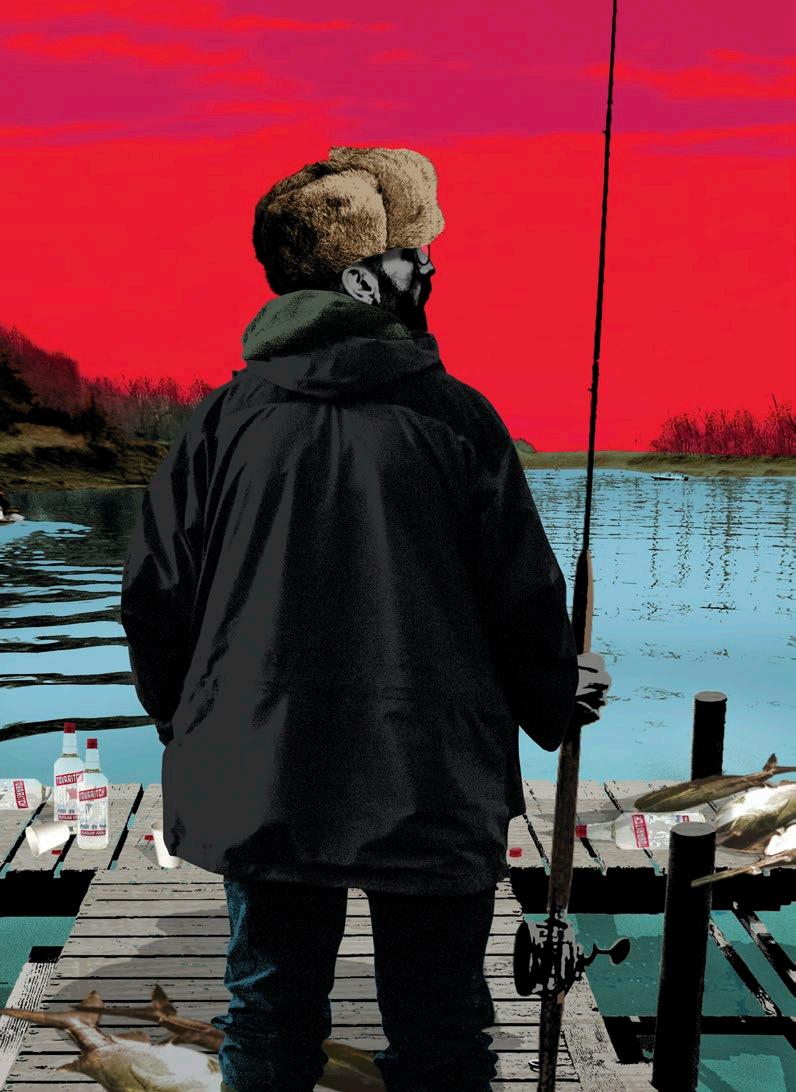
When Russian caviar prices soared in the mid-2000s, a tiny town in the US Midwest experienced a clash of cultures, and laws

at Cody’s Bait and Tackle in rural Warsaw, Missouri, in the Ozark Mountains, when two Russian men entered the shop and began rifling through fishing poles that didn’t yet have price tags. Reynolds asked them to stop, but they ignored him.
Reynolds, then 57, had seen plenty of Russians come through the shop. He was tired of them poaching the town’s beloved paddlefish.
He removed a .40-caliber pistol from under the counter, chambered a round, and placed it on the counter. The two men looked up, backed out of the store, and never returned.
It was just another dustup in the long-running war between caviarmad Eastern Europeans, local fishermen, and state and federal agents that centres on this unlikely town and a very curious fish.
The American paddlefish can weigh more than 160 pounds and measure seven feet long including its needle-nose snout. Paddlefish have another quality—their eggs taste quite a bit like Russian sevruga caviar. This curious fact explains why, in the mid-2000s, Russian immigrants began descending on tiny Warsaw (population 2,127), the paddlefish capital of the world.
For most of the 20th century, connoisseurs considered only the roe of beluga, Russian sturgeon, Persian sturgeon, and stellate sturgeon fit

for making caviar. But after the fall of the Soviet Union, several factors, including poachers, decimated the Caspian Sea’s sturgeon population. Russia restricted commercial harvesting. Prices soared.
The American paddlefish, a distant cousin of the Caspian sturgeon, is a mediocre substitute. The best Russian caviar has a clean pop and tastes of the sea. Paddlefish roe typically has an earthier flavour together with an inconsistent texture.
Yet it’s a sign of the desperate times
that a four-ounce jar of paddlefish caviar—a byproduct that for years local fishermen tossed back with fish guts—now sells for £42. A pregnant female paddlefish can contain up to 20 pounds of roe worth nearly £1,480 on the retail market. If a poacher sells the eggs as high-grade sevruga caviar, it’s worth £28,180.
Every single spring, tens of millions of dollars’ worth of roe sit at the base of Truman Dam, near Warsaw, when paddlefish stack up there high like piles of cordwood.
Eastern European fishermen are a more familiar sight here than one might imagine. Russian and Ukrainian immigrants who live in nearby Sedalia have fished in Warsaw for years. But by the mid-2000s, a very different breed of Russian was arriving in town every spring, driving flashy imported cars boasting out-ofstate plates.
Most of the men didn’t have fishing experience, but they’d drop hundreds of dollars on bait and tackle, hire guides, and drink vodka shots with breakfast. And they developed a reputation for overfishing. “The phone was ringing off the wall,” Rob Farr, the local agent for the Missouri Department of Conservation, told me.
is tough. Perps are often drunk, armed, and furious. Over the years, Hitchings found more covert ways to enforce wildlife law.
The two men drove around Warsaw, checking out popular fishing spots, including the Roadhouse, a shuttered restaurant and dock. Hitchings peered into the ruined property. Operation Roadhouse began to take shape. He wouldn’t catch poachers by casting out a line and reeling in one at a time. He’d throw chum in the water. He wanted a feeding frenzy.
When Felix Baravik pulled into Warsaw in the spring of 2012 after an 11-hour drive, the madness
State law in Missouri allows fishermen to keep just two paddlefish a day. So locals were angry. “They just ripped open the fish to remove the eggs, and let the carcass sink,” a commenter wrote on OzarkAnglers. com. “A similar punishment should be administered to the poachers.”
Around 2009, Gregg Hitchings, an investigator with the Missouri Department of Conservation, got a call from Farr. Would he make the trip down to the Ozarks?
Handing out tickets for overfishing
had already begun. The chance at landing a paddlefish had drawn anglers from all over the Midwest and beyond, practically doubling Warsaw’s population. Baravik and his buddies wanted to snag monsters too. Females. Lots of them.
Baravik, who managed a large home care agency in Denver, had grown up in Belarus in the Soviet Union. His friends—Arkadiy Lvovskiy, Artour Magdessian, and Dmitri Elitchev—were immigrants from former Soviet bloc states too.
Most of the Eastern European
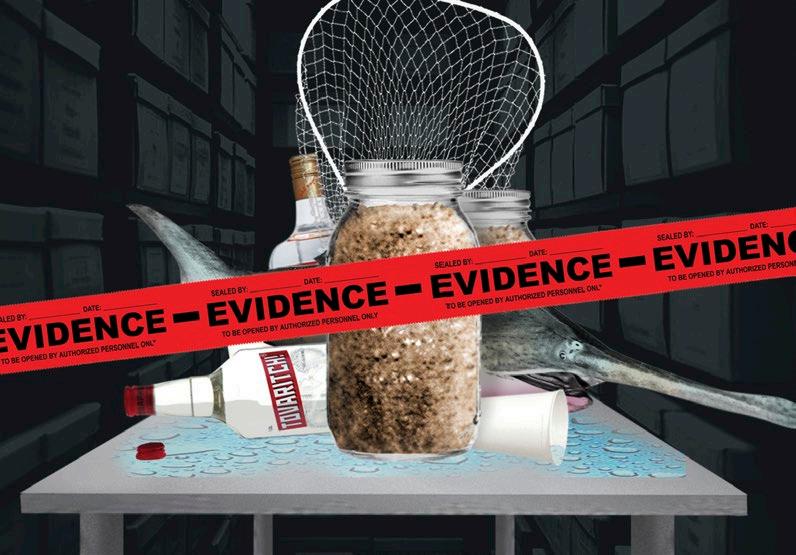
fishermen would have heard stories from their grandfathers about the 1930s, when a tin of caviar only cost twice as much as butter. When stocks dried up, caviar lovers turned to the black market. By the 1990s, overfishing and illegal exports had sent prices skyrocketing. Only oligarchs and gangsters could afford to eat it.
Baravik and his friends rented a cabin, bought fishing licenses and hit the Roadhouse, which was brimming with snaggers who paid £6 a day for a position on the small dock.
None of the fishermen on the Roadhouse dock knew about the investigation that the Department of Conservation was running with the US Fish and Wildlife Service. Gary Hamilton, the friendly middleaged man running the dock, was in fact Hitchings. The Roadhouse dockworker who sold day passes had a hidden camera over his shoulder and was keeping records of their personal information.
Money was changing hands all over Warsaw. Petr Babenko drove around
town buying up pregnant female paddlefish. Another man, Fedor Pakhnyuk, openly bragged that he had sold £10,570 worth of caviar in 2011. Now he was en route to buying 36 quarts of paddlefish eggs.
The Eastern Europeans wanted so many eggs, it was hard to believe they weren’t selling them. Hitchens’s idea was that the federal agents would follow the roe to a black market. Who knew what they would find? Russian mafia. An international caviar cartel.
stakes. The men who travelled from all over the country for a shot at knockoff caviar would not be denied.
A few days later, the four Colorado friends returned home. The undercover agents would have been justified in feeling confident. They had helped Baravik and his accomplices illegally buy and catch female paddlefish. The eggs were worth hundreds of thousands of dollars if they were mislabelled as
Baravik and Magdessian went snagging with two local guides— actually undercover agents—and landed seven paddlefish, well over the legal limit. Elitchev and Lvovskiy skipped the hassle and bought three females from another agent for £264.
The Russians drank. A lot. And with so much alcohol and competition over fish, it was only a matter of time until something popped. Late one night, Hitchings, who slept in a camper near the Roadhouse dock, was startled awake by shouting. Rival groups of fishermen prepared for violence, more than a dozen on each side. Weapons were everywhere. Beer bottles. Fishing gaffs. Handguns. Fists began to connect with dull thuds.
Undercover agents stopped the fight, but the brawl laid bare the
Russian caviar.
But there was a problem. Most of the men were buying female paddlefish, processing knockoff caviar and… eating it. Illegal, yes. But was it really the plot of a Russian mafia thriller? Hardly.
Some officers must have realised the miscalculation on March 13, 2013, when 125 state and federal agents descended on poachers across four time zones to make arrests.
During an interview, one poacher said the caviar was for his family to give guests when they came over.
“Why would I want to sell it?” he asked them.
“To make money,” an agent replied.
“Heck, no!”
Of the 112 defendants tagged with state or federal violations, four pled
guilty to felony trafficking charges and another eight, including Baravik, pled guilty to lesser misdemeanor charges. Only one case went to trial, that of Petr Babenko, the owner of a gourmet store in New Jersey. He was convicted of felony trafficking of paddlefish and given probation.
Fedor Pakhnyuk, who had openly bragged about his dream of an ersatz caviar empire, was released and ordered to refrain from drinking. Agents returned his personal
that even the men selling were not tributaries to a river of blackmarket caviar. The state and federal government had spent millions of dollars to protect a fish stocking operation that costs Missouri £70,470 a year.
A few of their collars were smalltime caviar hustlers. But most just really, really liked caviar. “Caviar is good,” Felix Baravik told me.
He knows he messed up. “I was in not right time with not right people,”
belongings: a leather jacket, £25 in cash, a lighter, two sticks of chewing gum and some papers. The head of a caviar cartel he was not.
A 2012 conversation during the second and final season of Operation Roadhouse, between an undercover agent and a poacher, was representative. The agent wanted to know how many more female paddlefish his client needed.
“Fifty, 20, 100, honestly,” the suspect replied. “We’ll take them all. We have a big family. We’ll suck up on them. Eat it all year.”
The Missouri Department of Conservation considers Operation Roadhouse a success. Paddlefish poaching is way down. But Hitchings acknowledged
he said. He confessed to one count of paddlefish trafficking, did three years’ probation, and paid a £3,523 fine, plus legal fees.
Recently, Baravik was travelling back from the popular resort town of Cancun, Mexico, with his family. At immigration, the customs agent studied his computer screen. The conviction had triggered a “lookout” note in his file. The agent pored over his criminal record. Baravik and his family watched with evermounting anxiety.
After studying his record, the agent finally looked up. His eyebrows were arched with incredulity.
“Fish?” he asked. “Really?”
Yes, really. n



Atlantic seal pups depend on this beautiful world of ice off Canada’s Magdalen Islands
 Story and photographs by Jennifer Hayes from national geographic
Story and photographs by Jennifer Hayes from national geographic
When you walk on sea ice, it’s easy to forget that there’s an ocean below you. This frozen world is stripped down to essentials: impossibly blue sky, bright sun bouncing off fresh snow, wind that vibrates like a cello, whiteness all around.
Then I hear the distant chorus of infant cries and I stand still, listening. It’s a precious moment that I want to appreciate fully before I pull out my cameras. I catch a slight movement in a ridge of snow ahead—a gentle and clumsy wave of a tiny flipper. I see a pup nestled inside a small snow cave molded by body heat and movement, protected from the wind. Its colouring is still tinged with hints of yellow from amniotic fluid.
I choose a spot a polite distance away and kneel in the snow, watching and waiting, noting the date: March 8, 2019. I hear sloshing water and short grunting breaths before I see a whiskered face with big dark eyes rise and survey the surroundings from a nearby hole in the ice. The female emerges, using curved claws to pull herself onto and across the ice to her pup. They meet with a nose-to-nose kiss of recognition that establishes kinship: Are you my pup? Are you my mother? The female turns to gauge my presence, determines I am no threat, and settles onto her side, shuts her eyes, and begins to nurse. Welcome to the harp seal nursery
in the Gulf of St Lawrence off the Magdalen Islands (Îles-dela-Madeleine), Quebec, one of two Northwest Atlantic harp seal whelping grounds. Adult seals migrate here from the Arctic, the pregnant females searching for suitable ice on which to give birth. Harp seals are an ice-obligate species: they require a stable sea platform of ice for pups to survive. Born on the ice in late February and early March, the pups nurse for 12-15 days before being left on their own. The young seals are among the most captivating creatures on the planet, with obsidian eyes, charcoal noses, and cloud-soft fur.
As I scan the landscape, I see

Seals are born on sea ice. Could this whitecoat be considering its first swim?
larger, more active pups in their whitecoat phase. These older pups, born days earlier, have the distinct advantage of time in the increasingly unpredictable world of climate change and its impact on this ice. Late-born pups especially need an adequate period of stable ice to survive in a world where spring comes earlier every year and, with it, increasingly strong storms that demolish the ice pack. A life born to ice is difficult, and natural mortality is high.
The Magdalen Islands, or the Maggies, as some locals affectionately call them, are an archipelago of islets resembling ships
at anchor in the Gulf of St Lawrence. I had been here in 2011 for a story about the gulf’s marine ecosystem. The boat we boarded then to meet the seals was a steel-hulled fishing— and seal-hunting—vessel. Magdalen Islanders have fished and hunted seals off these shores since the 1600s. It’s a controversial tradition that continues with strict quotas and regulations (no whitecoats)— despite a substantial decline in the number of seals harvested due to decreasing market price and unfavorable ice conditions.
“Given the market situation for hunting products,” our guide, Mario Cyr, told me, “ecotourism and observation tours are the best

Mother and pup establish kinship with a nose-to-nose kiss of recognition
alternative for most boat owners and hunters.”
After two days of searching, the boat’s captain nosed the vessel into a patch of sea ice supporting a herd of more than 10,000 seals. We drifted with the ice over several days and nights. It was extraordinary to pull on crampons and walk among this gathering of pulsating life on the ice and then to put on a dry suit, mask, and snorkel and slide into their world with a camera.
Life at the edge of the patch can be a busy place, with mothers coming and going beneath a dark-blue cathedral of ice pierced by shafts of light, apprehensive whitecoats peering into the sea
considering their first swim, and veterans gliding about and exploring their new ocean world.
The assignment was a photographic success, and it also gifted me with a life-changing moment. On our last day, as I floated respectfully near a mother seal and her pup, an aggressive male seal nipped at my ankles and scrabbled over my back, pushing me below the surface. The mother seal fought him off and then nudged both her pup and me out of harm’s way.
I was still processing this as our ship headed to port ahead of a low-pressure system. The storm tore across the gulf, whipping it to froth. By the time we made shore,
we learned that the sea ice had disintegrated beneath the herd and the pups had been lost.
The storm had made my encounter with the mother seal bittersweet and I knew we were now facing a new truth—that the world of ice was as fragile as a dream. The realisation galvanised my resolve to return each year that ice conditions would allow, to track the harp seals’ lives and connect others with these creatures and their diminishing realm.
Fast forward to 2019. The boat charter for our annual visit to the seal-nursery was cancelled; the fishing boats were “iced in.” But it was looking like a good year for seals, so we joined a helicopter ecotourism trip that takes travellers over the pack ice during seal pup season, landing only if conditions are safe.
That’s how I find myself watching a pup nursing, as its mother soaks up the warm sun. As I walk back toward the helicopters, I see a girl sitting quietly next to a chubby whitecoat staring back at her. Other
travellers I meet include a couple on a Valentine’s Day date, a cancer patient, and a Japanese photographer and guide celebrating his 30th year with the seals. There’s a young lady who brought her toy seal from childhood, and a 20-something man who slept in his car and ate canned goods after spending his last dollar for the season’s final helicopter ride. Passion and curiosity brought them all here to learn and grow.
Before my snorkelling encounter with the protective mother and her pup, I was a sceptic about humanwildlife interactions. But I now accept that sometimes things happen when we least expect it. Biologists can point out why a testosterone-fuelled male seal was compelled to challenge me while I was swimming with his potential mate. But they cannot easily explain why a mother seal would push me to safety with her pup.
I don’t need explanations. I just embrace it. n
The famous rainbow LGBT+ Pride flag was originally made up of eight colours. Hot pink was dropped because the colour was too difficult to source, and turquoise a year later so that the flag could be split in half to decorate both sides of a parade route. Today’s Pride flag also incorporates black and brown to represent people of colour, and baby blue, pink and white to include the transgender community

The pandemic has had one positive result: millions more Europeans have discovered the joy of cycling
ycling is easy,” says Tanja Jamnik. “Sitting on a bike, I feel very free. I can go anywhere I want—to the mountains or just around the village.”
The 57-year-old accountant from Kranj in Slovenia tries to get out into the countryside several times a week in summer. “I like to go to the hills because I enjoy the views,” she explains. “It’s hard work, but worth it.” A favourite ride is the 20 miles to Lake Bled near the border with Austria; it’s a fairytale lake against a backdrop of mountains.
Tanja is convinced of the health benefits. “Cycling is great for the whole body. Plus, three years ago I had surgery on my knee and the doctor told me that cycling was good for it.” And there are advantages for mental health. “If I cycle alone, I switch my mind off and all the bad things go out of it. If I cycle with a friend, we talk so much that it’s just like therapy!”
While Tanja and her husband, Andrej, have long enjoyed cycling, there are many newcomers to the activity. She ascribes the recent boom in biking in her country to two factors. One is Slovenia’s stunning performance in the 2020 Tour de France. Primož Roglicˇ dominated the competition before his compatriot
Tadej Pogacˇar snatched victory at the last moment.
The other, of course, is the COVID-19 pandemic. Last year when public transport was cancelled, and schools, sports facilities, restaurants, and shops were shut, many more Slovenians discovered—or rediscovered—cycling. “My son was working in a bike shop and sales went up 30 per cent,” Tanja says. “By the beginning of July, cycle shops in Slovenia were almost out of mountain bikes and trekking bikes.”
Tanja and Andrej often tour their home country by bike, plus most years they have had cycling holidays in other places, too. Her favourite memory is cycling the length of the Pyrenees between France and Spain, from the Mediterranean to the Atlantic, tackling 28 mountain passes


was really nice. It’s so much easier to make a connection with other people when you’re on a bike.”
She hopes to join other cycling commuters when she starts her new job in the capital, Ljubljana, about 12 miles from her home. Ljubljana is one of the most bike-friendly cities in the world, with 187 miles of cycle lanes, themed leisure cycling routes, and bike-repair stations. Four automatic traffic counters record more than 3 million bike journeys every year. And Tanja’s home city of Kranj has a good network of cycle paths and a rental-bike scheme, too. “Here,” says Tanja, “cycling is genuinely ‘in.’”
In fact, the whole of Europe has seen a phenomenal growth in cycling. Bike use was already high in some European countries, including the Netherlands, Hungary, Scandinavian countries, and Germany, but numbers are increasing
Emma Rawlinson sets off on a ride with her children
all across the continent as people get on their bikes for fitness, commuting, and leisure.
Because of the COVID-19 crisis, many have been pushed towards pedal power because cycling has become one of the few ways you can travel to work while social distancing, or stay fit on less-busy roads. In Finland, bicycle sales were up by 34 per cent in 2020, and in January 2021 alone, the growth was a staggering 49 per cent, according to the Finnish Cyclists Federation. In France, cycling exploded in popularity in 2021. Says Olivier Schneider of the French Federation of Bicycle Users, “In the last year or so, bikes have been flying off the shelves, with some shops completely selling out.”
One COVID-19 convert is Emma Rawlinson, 37, from Lancashire here in the UK. In spring 2020, she found herself working from home because of the pandemic. At the same time, her two children Harris, four, and Rosa, three, were not attending school and nursery. Emma saw their confinement as the perfect opportunity to start cycling as a family. “I wouldn’t have been able to spend time with them if it were not for lockdown,” explains Emma, the owner of a small publicrelations agency.
“It was then that we realised how many unnecessary short journeys we were making in the car,” Emma says.
“We’d drive to my mum’s or we’d drive to the shops. But if the weather is nice, we don’t need to do that. We have bikes and the children are getting more confident on them.”
Cycling has increased the family’s awareness of the world around them. “If we were in a car, we’d all either be listening to the radio or not really talking but just looking out of the window at other cars,” Emma says. Now they’re taking in their surroundings much more. “I’ll be saying, ‘Look at the horses in the field,’ or, ‘Can you see that the leaves are changing colour?’”
The family has taken advantage of rural roads that their local council closed to motorised traffic as part of a “switch to cycling” campaign, launched during lockdown.
Christophe Marquis visits Château de Raray near Paris on his customised road bike


feel young again,” she says. “When lockdown restrictions eased slightly, I used my bike to go and doorstepvisit my friends.” Emma’s friends were surprised to see her arrive on a bike. “I’ve just cycled here, it’s amazing!” she told them.
“They had road closures for easier access and they’ve been putting on courses for people to get into cycling,” says Emma. The campaign has also publicised new initiatives such as the government’s Fix Your Bike Voucher Scheme, offering £50 off the cost of repairing a bike.
Cycling to school is now part of the Rawlinsons’ routine. “On bikes, we can go under the motorway and it takes three to five minutes,” Emma says. “If we went in the car, we’d have to go around the motorway; it could take 20 minutes. It makes no sense to do that any more.”
For Emma, there were personal benefits too. “It really made me
However, she would like to see a better network of shared paths for cyclists and pedestrians in the UK. “It would make people more confident to try cycling because they’d know they don’t have to go on the road, that there’s some sort of infrastructure there.”
Paris is leading many other cities in welcoming cyclists. In a bid to reduce traffic and pollution, Mayor Anne Hidalgo has recently created hundreds of miles of new cycle lanes, many of them segregating cyclists from drivers; the lanes are nicknamed coronapistes. Bicycle use in Paris has
reportedly increased by almost 70 per cent since spring 2020. Meanwhile the French government offered people all over France 50 euros off bike repairs or a free back-to-cycling session.
Vélo & Territoires put the increase in cycling in the five months after the first lockdown at 62 per cent over the same period in 2019.
Most cyclists in the French capital are commuters who now see what they do as a lifestyle, known as vélotaf. One bike commuter, Christophe Marquis, can testify to the explosion of Paris vélotafeurs. But it’s not always pretty. “Paris is well equipped, but there are a lot of idiots,” says the 56-year-old aircraft technician, who lives in the Paris suburb of Le Raincy, around 11 miles northeast of the city. He cycles both in the city centre and the 12 miles to work at Charles de Gaulle airport.
“There’s the bike-car problem, and the bike-bike problem,” he says. “In Paris, it’s the bike-bike problem. I think there are a lot of new cyclists who were previously in their cars and were used to fines based on video surveillance. On a bike there’s no registration plate. So with their new-found liberty, they do exactly as they please.”
Christophe sees them turning without warning and cutting in front of cars. “Then you have drivers who are convinced that bicycles are trying to usurp cars and it’s all-out war,” he says.
Cycling to work in the suburbs, where the road infrastructure favours the combustion engine, Christophe faces different challenges.
“Sometimes you have to accelerate to cross a lane where cars and lorries are travelling very fast. It’s not practical and sometimes it’s not very wide, so cars and trucks overtake very close to you.”
But he rarely uses his car. “The car is more expensive, less environmentally friendly. It makes you put on weight, and is less good for your health,” he says. “On my bike I don’t have parking problems.” And he can’t help feeling a sense of satisfaction when he comes across a traffic hold-up in the city because of a demonstration. “I give them a little wave as I go by,” he says, laughing.
Europeans are jumping on e-bikes too; sales are predicted to grow from the 3.7 million sold in 2019 to 17 million in 2030. These electrically assisted pedal bikes—also known as “pedelecs”—are credited with making seniors more mobile.
That’s certainly been the experience of Charly Kumfert, 65, from Stuttgart, Germany, who got rid of his second car and bought an e-bike when he took semiretirement from his job at a car parts manufacturer in 2018. Now fully retired, he gets out on his pedelec at least three times a week to go
shopping, to his allotment, or to his brother’s for coffee, usually on the extensive network of cycle routes in the hilly region where he lives.
“I am definitely in better shape,” says Charly, whose trips average around six miles. When he’s at his garden, there is a long staircase to walk down and then back up. “At the top, I would often run out of breath; now, I manage it almost without any problem.” Studies show e-bikes can help improve fitness, cardiovascular health, and blood glucose levels.

Germany is Europe’s biggest market for e-bikes. They have a maximum speed of 16 miles per hour and, unlike the more powerful speed-pedelecs, which are in a different vehicle class, need no driving licence, registration document, licence plate, insurance, or helmet, although Charly wears one anyway.
There’s a certain amount of rivalry between e-cyclists and those on conventional bikes. “The other day I rode past a racing cyclist on a small climb,” Charly recalls. “It was easier for me, of course, because I have a motor that supports me, but the other cyclist seemed to take it personally. He then pedalled so hard that he passed me again. I let him go. If it makes him happy….”
If you rely on an e-bike’s motor too much and don’t pedal enough, you can find yourself stuck, as Yolande Haubert discovered. Some years ago,
swapped her traditional bike for an e-bike so she could accompany her partner Jean-Bernard Elie, 68, a keen cyclist. “I had a good road bike before, but I’m not that sporty and I couldn’t keep up with him,” Yolande explains.
On their very first trip away with the e-bike, Yolande turned up the motor to full power to help her heavily laden bike on a series of very steep sections.
“Six miles away from where we were due to spend the night, the battery died,” recalls Jean-Bernard, a retired bank official. “Yolande couldn’t pedal because the bike was too heavy, so we had to stop at a bar for three or four hours to recharge the battery.”
But, pedelec or pedal bike, the joy of cycling is now accessible to all, more than ever before. As Emma Rawlinson says: “There’s no better time to start. All you need is a bike and a helmet.” n
Two years ago , before the coronavirus, before even the roof of Notre-Dame de Paris burned down, sending shock waves to the core of our allegedly secular society, I gazed upon Quasimodo’s home for the first time. I was stood on the Quai des Orfèvres, the poetically named street that runs along the left bank of the Île de la Cité, where the police judiciaire, headed by Inspector Jules Maigret, is headquartered in the 75 Maigret novels penned by Belgianborn writer and pipe-smoking enthusiast Georges Simenon between 1931 and 1972. This street, which reminds me of the former GLC building on London’s South Bank, now the London Dungeon, interests my philistine brain more than what awaits on the other side


of the river, the object of today’s expedition. That is Shakespeare & Company, the legendary librairie, frequented by such luminaries as Hemingway, Fitzgerald, and Joyce. Here, I share a cigarette with a Parisian named Pierre, who cautions me against giving my details to the fraudsters who stalk the Tuileries
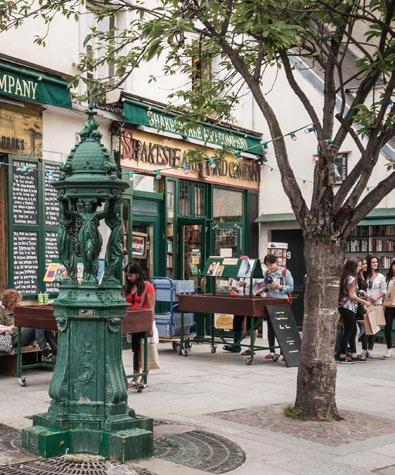



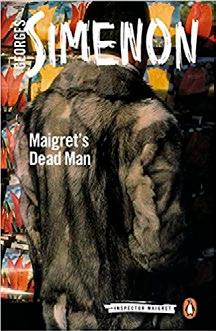
Garden, where a body is discovered in Maigret’s Dead Man, which I purchase for an inflated sum from a young tumbleweed, the name given to aspiring luminaries who come from all over to stay at the shop.
Later, as I stand on the bank of the river and watch the sun set over the Louvre—once the only way a commoner like me could catch a glimpse of this magnificent former palace—I feel a stirring of the sort that once propelled this great nation to revolution. n
Tell us about your favourite holiday (send a photo too) and if we print it, we’ll pay £50. Email excerpts@readersdigest.co.uk

Gibraltar’s small size—at just three miles long and 0.75 miles wide—and its cruiseship crowds can make escape difficult. Difficult, but not impossible. For most visitors to this bijou British territory, occupying a headland in southern Spain, frequent the same, monkey-lined Rock of Gibraltar sites.
Aided perhaps by its easily-missed wrought-iron gates—behind the cable-car parking lot—far fewer make it to the Alameda (or Gibraltar) Botanic Gardens, despite this 15-acre escape being free to enter.
Awaiting are a colourful collection of botanical plants in distinct habitats, plus lots of seating areas, and harbour and Upper Rock views. A particularly large amount of succulents, including lots of aloe vera, grow alongside a 300-year-old dragon tree, date palms and bright bougainvillea. Look out for the sunken lawn with its castle design, and the wooden bridge across African gardens.
Amid all the greenery, you’ll also find lots of stairs—be warned—as well as military statues and a bronze of Gibraltarborn character Molly Bloom from James Joyce’s novel Ulysses. There’s a theatre, too, used occasionally for weddings or other events. Above all, and especially beside the various waterfalls, you’ll find much shady tranquility.
Founded in 1816, the gardens fell into disrepair during the 1970s and were salvaged two decades later. In 1994, a derelict mini-golf course on their far fringe was converted to form the adjoining Alameda Wildlife Conservation Park (£6, awcp.gi): caring for animals seized from illegal traders. This hosts lemurs, snapping turtles, tamarin monkeys and tortoises. n
By Richard Mellor

Andy Webb on keeping your spending habits in check now that we are out of lockdown
Ireally hope that by the time you read this the coronavirus vaccination programme will have enabled most lockdown restrictions to have eased. This would mean shops, bars, restaurants and other businesses open and eager to take our money. And no doubt, many of you will be keen to spend it too. But getting straight back into it isn’t necessarily the right thing for your finances. There are some pandemic money matters that need to be addressed before you hit the high street.
With newly regained freedoms, catching up with friends and family is going to top of the agenda for me, and I’m sure you too. But every meal out, every train journey, every hotel… it all adds up.
If you don’t want your savings to disappear, I’d recommend creating a post-lockdown spending plan to work out just what you can afford to splurge on.
Whether it’s a lump sum or a regular amount each month, knowing just how much you have available will stop your spending from getting out of hand.
It’ll be easy to go all-in on available spending opportunities in those early months, but it makes sense to decide where you’d rather put your cash.
For example, does it go towards new clothes or towards social activities?
And there’s still some way to go. One area that might still take some time to return are holidays.
If you want to ensure you’ve enough for this, or want to upgrade your normal break to the next level, make sure you partition some of your splurge fund to pay for this.
Dealing with the pressure to spend
Of course it’s easy to say don’t overspend, but emotions can often take over. Pressure from friends and family to meet up and do things, along with your own desires to regain some kind of normalcy, can distract you from the best laid plans.
If there’s a chance that splashing out could cost more than you can afford, please don’t ignore it. Be upfront with everyone and suggest cheaper or free alternatives.
And not everyone is better off financially due to the pandemic. If you know someone has been furloughed or lost their job, their situation is going to be very different to someone who’s kept working but cut out commuting and other costs.
So it’s worth bearing that in mind

Andy Webb is a personal finance journalist and runs the award-winning money blog, Be Clever With Your Cash
when you’re suggesting or planning activities with others.
If you’re going to spend in new ways, then you want to make sure this replaces rather than adds to your lockdown expenses.
Things like online shopping, takeaways and streaming services all seemed affordable (and hopefully were) when we were stuck at home, but do you really need to keep paying for them?
Before the pandemic we would have been victim to spending habits that have now been broken. These could be simple things like getting a posh coffee everyday, through to grabbing a taxi rather than walking.
Have you actually missed these things? If not, don’t just automatically return to them.
For lots of people there have been some enforced changes which haven’t been too bad. Things like taking the time to cook more from scratch, or taking up new hobbies.
Often these are cheaper than what we’d have done before, meaning that
sticking with them is a certifiable win for your wallet.
For those who’ve been saving rather than spending in the last year, the challenge will be how to keep this going when you’re suddenly able to do and spend more.
My top tip here is to prioritise your savings by sorting the payment before any extra spending.
To do this, start with your total income for each month, then deduct your essential expenses and bills. Factor in some money for groceries too. Now, what’s left?
Decide just how much of this remaining amount you want to save and set up a standing order from your bank account to a separate savings account the day after payday. This’ll prevent a “spending creep” slowly eroding your savings pot. n
It would take 375,000 Lego bricks stacked on top of one another to destroy the bottom brick—the tower would be nearly 12,000 feet tall
Q: I have three wonderful adult children and the will I made years ago states that my estate should be equally split between them. However, the older two have already lived successful lives, with partners, children and the security of owning their homes. My youngest however, is still single, and not on the property ladder. This is more of a moral question, but do you think changing the will to benefit my youngest more than the eldest would be a mistake?
- Lorraine, 76
A: This must be a common worry for so many parents. Financially the logical decision would be to help the person who needs it most. But as you acknowledge, this isn’t solely about the money.
Doing this could cause all sorts of issues and put a lot of strain on your relationship with your other children. It might also lead to a rift between your kids when you are

gone. How do you think they’d react? Would it be positive? Would they understand your intentions?
And though this is the situation right now, so much can change, and you’ve hopefully got a good few decades left in you yet! So changing the will now, might mean making more changes later.
You could consider protecting your youngest in other ways. For example, if you own your house outright, you could perhaps stipulate in a codicil that they’d be able to live there and therefore not be forced to sell the property. But when they do, the money is split between all three, or your grandchildren if they have survived their parents.
Of course that idea could be nixed if the property sale is essential to fund your inheritance tax bill.
I’m not a solicitor though, so I’d definitely chat to one about the options available to you if you wanted to go down that route. n
Got a money question for our resident expert? Email it confidentially to onthemoney@readersdigest.co.uk

Ask anyone what my favourite food is and they will tell you, “chicken nuggets”. Good ones, bad ones, take away ones, luxury ones and homemade ones. They are my go-to, my ultimate comfort food, and the thing I just cannot say no to! So of course I had to create my ultimate chicken nuggets—flavoursome, quick and easy, and addictive in the best way. There are even dips for you to try, or you can just stick to good
old mayo, pop them in a bun or take them on a picnic! These are proof that nuggets aren’t just for kids, or for a boring lastminute weeknight tea, or always purchased from a drive through (though I can’t promise I won’t “occasionally” eat these!). I must warn you, don’t try and steal my last nugget, and you’ll want to make double portions.

1 Pour the milk and lemon juice into a large bowl and mix together. Set aside for a couple of minutes and you’ve got homemade buttermilk!
2 Chop the chicken into nugget-sized chunks or goujon shapes, depending on what takes your fancy. Drop the chopped chicken into the buttermilk, cover with cling film and place in the fridge for at least 3–4 hours, or overnight if possible.
3 Preheat the oven to 160°C fan (180°C/350°F/Gas Mark 4).
4 Put the cornflakes, grated Parmesan, garlic powder, parsley, paprika, cayenne pepper, rosemary and some salt and pepper in a food processor and blitz until rough jagged crumbs form. If you don’t have a food processor, then bash the cornflakes in a Ziplock bag and finely chop the parsley before mixing all of the ingredients together. Tip the cornflake mix into a separate bowl.
5 Remove the chicken from the fridge and roll the marinated nuggets in the cornflake mix. The cornflakes should stick all over the nuggets, coating them completely.
6 Lay the coated nuggets on a baking tray and cook for 18–20 minutes until the nuggets are cooked through and the coating is crispy and golden.
7 To make the spicy sriracha mayo, mix all the ingredients together in a small bowl.
8 Serve the nuggets hot alongside the spicy mayo—those not feeling too brave can have plain mayonnaise instead!
Find this recipe and more in Happy Cooking by Candice Brown, Ebury, £22
Serves 4
(Though I could eat them all solo to be honest)
• 3 skinless chicken breasts
• 150g cornflakes
• 50g Parmesan cheese, grated
• ½ tsp garlic powder
• small bunch of fresh flat-leaf parsley
• 1 tsp smoked paprika
• ½ tsp cayenne pepper
• 1 tsp dried rosemary
• salt and freshly ground black pepper
Homemade buttermilk:
• 500ml whole milk
• juice of 1 lemon
Spicy sriracha mayo:
• 3 tbsp mayonnaise
• 2 tsp sriracha sauce
(more if you like it spicy)
• zest of 1 lemon
• splash of Tabasco sauce
• small bunch of fresh chives, finely snipped


Sesame prawn toast is an all-time favourite part of a Chinese takeaway but have you ever tried making your own? Not only does it make for a satisfying small snack, but it’s also a great way to use up the leftover bread that’s been sitting in your bread bin.


Prawn toast is a Hongkongese-Cantonese dim sum dish and is an example of an early form of fusion cuisine, combining prawn paste—a staple of Hong Kong cuisine—and toast, which originates from the West. Don’t forget soy sauce or sweet chilli sauce for dipping!
1 Place the prawns, garlic, ginger, egg white, sugar and soy in a food processor and blitz to a paste. Stir in the spring onion. Scrape into a bowl, cover and put in the refrigerator for at least 30 minutes.
2 Lightly brush one side of each slice of bread with sesame oil. Spread the prawn mixture on top. Brush the beaten egg carefully over the top and sides and sprinkle liberally with sesame seeds so they stick to the prawn mixture.
3 Heat an inch of vegetable oil in a sauté pan or deep frying pan until hot, and cook each piece of bread (it’s easier to cook one at a time). Firstly, cook the non-spreaded-side down for 1½ minutes, then carefully turn over and cook for 1-2 mins on the prawn side or until the sesame seeds are golden and the prawn paste is cooked through.
4 Cut each piece into four triangles and enjoy!


Serves: 4
• 200g prawns, peeled and cleaned
• 1 garlic clove, roughly chopped
• 1 tsp grated ginger
• 1 egg white
• ½ tsp sugar
• 1 tsp soy sauce
• 2 spring onions, finely chopped
• 3 slices of white bread, with crusts removed
• Sesame oil, for brushing
• 1 egg, lightly beaten
• 100g sesame seeds
Give your plant pots some extra height with DIY legs
I’m of the firm belief that you can never have too many houseplants. I’m obsessed! But of course, for every new plant I get, I also need a new plant pot for it to live in. This DIY tripod planter transforms a plain pot into something much more eye-catching. The angled wooden legs introduce an on-trend mid-century feel, and add some extra height. They also give the pot a much more premium look—who’d have thought that it started life as a £2 IKEA bargain?!
You will need
• A plain plant pot
• Wooden dowelling
• Strong all-purpose glue
• Mitre saw, or hand-held saw and clamps
• Sandpaper
• Ruler
• Pencil

Mike Aspinall runs one of the UK’s most popular craft blogs, The Crafty Gentleman, where he shares free DIY tutorials
How to make it
1. First up, you’ll need to decide how high you would like the legs of your plant pot to be. As a rule of thumb, I would generally recommend making them half the height of the planter itself. So a 20cm planter would have 10cm legs.
2. With your height decided, use a pencil to mark out three identical lengths of dowelling.
3. Time to cut! The key thing to remember here is to cut each leg with slanted edges and that both ends must be slanted in the same direction. This is what will give your plant pot legs their angled effect. Make sure to aim for a 15-25 degree angle. It’s easiest to achieve this with an adjustable mitre or table saw, but you can also do it with a hand-held saw if you don’t have them. Just make sure that you clamp the dowelling firmly to your workbench if you go for the latter option.
4. With all three legs cut out, sand down the edges to smooth them and remove splinters.

5. Turn your plant pot upside down, and make a small pencil mark at three even points around the edge. Apply a generous amount of strong glue to the end of one of your wooden legs, then stick it directly to the plant pot (using the pencil marks as a guide). Wipe away any excess glue with a clean, wet cloth. Repeat for the other two legs.
6. Leave the plant pot as it is for 30 minutes, so the glue settles and begins to set. Then turn the pot the correct way round, so the legs are underneath. Gently place it down onto a wipe-clean surface (be aware that the glue might drip a little). The weight of the plant pot should ensure a firm pressure between the pot and the legs. Leave this to dry for 24 hours.
This basic process can be applied to any size of planter—simply adjust the thickness of the dowels you use, to match the pot you’re adding them to. You could even experiment with painting or staining the wooden legs, or changing the lengths of them. n





From sunny yellows to pretty pinks, this summer’s trending colours are rooted in hope and optimism. But just how powerful can a colourful wardrobe be for influencing our emotions?
The first sip of coffee in the morning. Your favourite song playing on your journey home from work. A glass of Aperol Spritz on your holiday. These things all have something in common—they release dopamine, one of the “happy hormones” that make us feel good.
Dopamine acts as a messenger between the neurons in the brain and strongly affects our mood. When we have high levels of dopamine going back and forth between neurons, we feel great. On the other hand, low levels of dopamine have been linked to reduced motivation, decreased enthusiasm and depression.
Luckily, there are many ways we can boost our dopamine levels, and one of these—“dopamine dressing”— suggests that the clothes hold the power to boost our mood.

Bec Oakes is a Lancashire-based freelance journalist with particular passions for fashion and culture writing
Personally, I’m fully on board. Earlier this year, I attended the wedding of one of my oldest friends in a floral-print midi dress by Rixo. After a year of working from home, often foregoing getting dressed in favour of staying in my pyjamas, it was my first taste of dressing up in a while. And honestly, I haven’t felt so great in a long time, so much so that I kept the dress on all day, long after the reception ended.
The concept of dopamine dressing—actively choosing clothes that bring us joy—is nothing new. A 2012 study found that when participants wore clothes of symbolic meaning to them, their perceived confidence increased. And, with mental health at an all-time low due to the COVID-19 pandemic, it feels more relevant than ever. As we turn our backs on the tumultuous past year, could happy clothing equal a happy summer?
The fashion world surely seems to think so with many designers harnessing the mood-boosting power of colour; their spring/summer 2021
collections bursting with joyful and energetic hues. Sunshine yellows brightened up the runways of a number of brands, with luscious lemon dresses at Versace and hints of yellow among accessories at Fendi. Elsewhere, vibrant orange hues were seen at Burberry, Christopher John Rogers and Sportmax, in everything from dresses to knitwear. And, headto-toe red ensembles were a common theme at Balenciaga and Givenchy
But, the stand-out colour of the season is undoubtedly pink, with a range of shades from ultrafeminine pastels to bright fuchsias dominating the runways of Chanel, Isabel Marant and Halpern. The colour has since taken over the high street, most notably in a pair of hot pink wide-leg jeans from Zara (pictured) which went viral on social media soon after their release.
shot—all great signs for summer’s trending hues.
Talking to Who What Wear in 2020, author of The Little Book of Colour Karen Haller said: “Colour is a great way to lift our spirits and boost our moods,” noting that wearing bright colours delivers an emotional response both for the wearer and the observer. “We instinctively feel and behave differently around colours because of how we take the colour in through our eyes and through to the part of our brain where our emotions reside.”

US fashion psychologist
According to colour psychology, which associates different colours with different emotional responses, on top of elevating your appearance, wearing this season’s trending colours can also result in an elevated mood. It tells us that citrus hues imbue us with optimism whilst fuchsia is said to inspire confidence and red is the colour equivalent of an espresso
Dawnn Karen has seen first-hand the power of harnessing colour in our wardrobe. She explains: “I had a doctor client who had geriatric patients dying from COVID, she was suffering from depression and on her days off from the office, I told her to wear yellow. So, she wore a yellow face mask and yellow underneath her white doctor’s coat and her mood instantly improved.”
So is it possible to dress ourselves happy? I think so. But, instead of prescribing to centuries-old colour theories, dopamine dressing in 2021 should be about wearing what makes us feel good. So, whatever garment it is, go out and find the colours that spark joy for you! n
Jenessa Williams asks whether tanning water is really the streak-free salutation to our tanning woes
With many of us forgoing our usual international summer holidays, sunshine-in-a-bottle might be the way forward when it comes to securing a good, safe tan. Fake tan is nothing new, but tanning water is rapidly growing in popularity for its dual purpose—hydrating the skin as well as colouring it. Buy yours in bottles, drops or even jumbo eco-refill plastic bladders, available from most high-street beauty retailers.

might. For those who experience breakouts with tanning products, water-based solutions can add colour without clogging pores.
In comparison to creams and lotions that many of us are used to, tanning waters are said to help avoid the dreaded bedsheet-transfer and biscuit smell. Given that your tan will develop in four-six hours without feeling sticky, you’ll be able to dress and go about your day as you please, trying where you can to avoid contact with water.
Leading brand Isle of Paradise also offer colour-coded products—peach to brighten pale skin tones, green to neutralise redness and violet to counteract dull skin, in much the same way a concealer or foundation
Although tanning water is toted as great for beginners, it's still the case that careful application is required for a neat finish. A good exfoliation first is essential, and complete novices may want to recruit somebody to help them with the application—even with the lightest tans, you want to keep a relative distance to the body as you spray to avoid patchiness, given that you are unlikely to see quite how dark the colour is until it’s dried. Take your time, and build up application over a few days rather than rushing on the morning of an event. Once you’re confident, spray waters can be a useful tool to have on hand. Smaller and easier to transport than the traditional creams, they're particularly useful in that you can cover your whole body with one product. Lasting up to five days, they can add a real boost of confidence without a big price tag. n



‘CONTROL FREAK’ is a novel about love, marriage, relationships and control. It is the story of Josephine, a young and somewhat naive woman, who finds John, the love of her life. Or so she thought. Everything is wonderful. That is until they are married. Then things change, not immediately, but day by day, week by week, month by month. But because there is no out and out physical violence, it takes her time to realise she is in an abusive relationship. That the love is gone, if there ever was any. But what will happen when she decides to end the relationship?












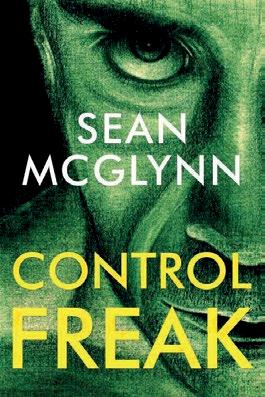


Sean McGlynn is a retired solicitor/ lawyer from, and living in, Letterkenny, County Donegal, Ireland. He is married to Catherine for over forty years and is a father, and grandfather. As a solicitor he ran his own practice from 1990 to 2011. During that time he has dealt with many legal issues, including the abuse of women by their partners. One victim, sadly, did not survive. ‘Control Freak’ is his first novel based on his experiences.
facebook.com/sean.mcglynn.752
‘Control Freak’ is available in paperback and e-book from Amazon.co.uk, paperback available from Waterstones, W.H. Smith, Foyles.co.uk, Brownsbfs.co.uk or directly from Pegasuspublishers.com from £8.99.

A balmy Western about friendship and making cakes? Don’t mind if we do!
Set in 1820s Oregon, First Cow is about harsh frontier life where the forests are dark, clashes between settlers over resources intense, and bloody bar brawls as matter-of-fact as getting up to go to the bathroom. Yet, in a remarkable feat of directorial sleight of hand from Kelly Reichardt, we get lost in a visually supple, magical world that paints the screen with kaleidoscopelike hues. The story kicks off with a chance meeting between two ragtag travellers—a shy baker who calls himself Cookie and a savvy swindler, King Lu. Struggling to make money, they decide to join forces and make a fortune by selling cakes. The idea
is an instant success, but there’s one small problem: they need to steal milk from the only cow in this corner of the world that belongs to a rich landowner played by Toby Jones.
There’s a delightfully sensuous quality to First Cow—the way Cookie poeticises the flavour of milk and honey, the way Toby Jones savours the word clafoutis, as if relishing the cake’s texture every time he utters it; the way they deliberately sip whiskey like it’s a mythical mead. “ Everything’s old if you look at it that way,” says a judicious King Lu at some point. Thankfully, that’s not the case with Reichardt whose ability to make us see the extraordinary in ordinary things is what makes this seemingly bleak film sigh and swoon-worthy.
By Eva Mackevic ©Four more unusual, artistic Westerns you should check out…

Johnny Guitar (1954)
Critics didn’t quite know what to make of this Western drama that eventually became a cult classic. Made on a laughably small budget, the film consists of a ridiculous plot, weird interiors, over-the-top dialogue and, er, Joan Crawford in a leading role. Telling the story of a sharp-dressing saloon owner (Crawford) who gets wrongly accused of murder and robbery by a lynch mob, it remains a wonderfully bizarre B-film to this day.
Dead Man (1995)
A quirky, quiet, black and white Western directed by Jim Jarmusch, Dead Man tells the story of a meek accountant who’s on the run after committing a murder. He encounters an enigmatic Native American spirit guide who believes he is a reincarnation of poet William Blake. Dubbed a “psychedelic Western” by its director, the film is full of dreamy imagery, subtle humour and discerning ideas. Not to mention a superb, aching soundtrack by none other than Neil Young.
El Topo (1970)
Fans of Alejandro Jodorowsky know that nothing this director ever makes can be considered “normal”. A master of otherworldly, psychedelic cinema, his movies are deeply embedded in symbolism and mythology, painted with stark, trippy colours. Such is the case with this beautifully shot picaresque journey of a mysterious gunslinger who encounters a number of bizarre characters on his way. Dripping in violence and blood, it stirred up a lot of controversy upon its release.


The Ballad of Buster Scruggs (2018) Coming from the selfconfessed Western fanatics, Joel and Ethan Coen, The Ballad of Buster Scruggs is a collection of six vignettes centred around the Old West and death, yet each with its own distinctive look, feel and thematic obsession. Featuring a star-studded cast including Liam Neeson, James Franco and Tom Waits, it’s a contemplative, offbeat anthology that’ll keep you on your toes.

Adapted from Colson Whitehead’s Pulitzer-winning novel, The Underground Railroad (Prime Video) feels like 2021’s first major TV event. A streaming budget has allowed Moonlight director Barry Jenkins to push further in his depiction of slavery than, say, Roots did two generations ago. Certain sounds and images here—a shot from a dying man’s point of view, whipcracks that resound like thundercracks— linger in the mind long after you’ve switched off for the night. Yet Jenkins also manages to strike a balance between the brute horror of slavery and the beauty of the America into which our fugitive heroine Cora (Thuso Mbedu) escapes: a land of great promise, improperly divided. Through it all chuffs the titular proto-Tube—a flourish worthy of a fairytale, allowing us to journey through the centre of the Earth, and onwards towards the light.

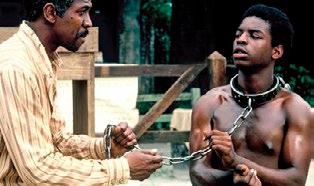
Race relations prove central to two more notable shows this month. Ripping its title from the pages of Conrad’s Heart of Darkness, the rigorous Exterminate All the Brutes (Now TV) finds the Haitianborn, European-raised filmmaker Raoul Peck revisiting the history of white supremacy, and taking the sandpaper of his voice and the scalpel of his mind to any remaining preconceptions you may have had about colonialism. On a larkier note, the fourth series of Fargo (C4; All4) describes a Kansas turf war involving a hood known as Rabbi Mulligan (Ben Whishaw): born Irish, but transferred into Jewish and Italian crime syndicates before being pitched into battle against Chris Rock’s all-Black mob. The moral of the story is this: the history of race in America, and elsewhere, would appear far more complicated than any of us have been taught.
by Mike McCahillRoots:TheCompleteMiniseries (Prime Video)
Another landmark: ABC’s 1977 adaptation of Alex Haley’s family saga concluded with the second most watched show in US broadcasting history.
Live albums can be a contentious matter. Some, one could argue, are a pretty blatant way for record companies to make an extra buck off old material, but some are a godsend—and we’d certainly classify Merci Miles! Live at Vienne as the latter. Recorded at the gorgeous Théâtre antique in Vienne, France, in 1991, it was one of Miles Davis’ final performances, as the legendary trumpeter sadly died later that year.
A double LP consisting of eight tracks, it’s a wild, riveting concert with Davis tirelessly ripping it up on the trumpet throughout an eclectic set list: there’s the near-20minute reinterpretation of Michael Jackson’s “Human Nature” that starts out as a pretty faithful, mellow cover and culminates in a farrago of sexy bass, syncopated beats and pure chaos. Then there are two tracks written by Davis’ long-time friend, Prince: “Jailbait” and “Penetration” which ooze his signature smooth funk vibes, swagger and audaciousness.

Weaved in between are the rapturous screams and applause from the audience in awe of the Prince of Jazz in what would turn out to be one of his last performances.

Supporting Davis is an equally exquisite band who follow his unpredictable twists and turns with supernatural-like aptitude. There’s the amazing Ricky Wellman beating his drums with such earthshattering power that you can almost hear sweat drops hitting his cymbals.
Sparring with Davis on the sax is the young Kenny Garrett who, while playing a solo in what can only be described as a convulsive trance, accidentally drops his mic. Then again, playing with Miles, you could never do things nice and easy.
by Eva MackevicMark Billingham returns with a compelling whodunit that takes Alice down the rabbit hole
Mark Billingham Little, Brown, £20
Mark Billingham’s new stand-alone novel (ie, one that doesn’t feature his longstanding detective, Tom Thorne) is a whodunit set on a psychiatric ward. The book carries out its whodunit duties—a shifting series of credible suspects, plenty of neat twists, a conclusion that’s both plausible and unguessable—with undeniable skill. Nonetheless its main interest, for Billingham and the reader alike, perhaps lies elsewhere: in the brilliantly realised setting and particularly in the richly nuanced character of its narrator.
The suitably named Alice has

James Walton is a book reviewer and broadcaster, and has written and presented 17 series of the BBC Radio 4 literary quiz
The Write Stuff
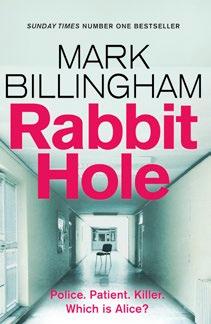
entered the rabbit hole of life on the ward after a major breakdown. Among other things, this caused her to smash her boyfriend Andy over the head with a half-empty wine bottle. Then again, the way she saw it that night, she didn’t have much choice. Andy was refusing to help her defend herself against some person or persons unknown (and indeed non-existent) who were coming to kill her as part of a vicious conspiracy involving her parents and most of her friends. As she now understands it, her paranoia was triggered by the posttraumatic stress disorder she suffered
when a fellow police officer in the Met was stabbed to death in front of her— and by her consequent ingestion of large amounts of drink and drugs.
But does she understand it rightly? This is the question that Billingham keeps beautifully, tantalisingly unanswered for most of the novel. At times, Alice seems a lucid guide to the “craziness” around her, describing the other patients with a mix of irritation, pity and dark amusement. At others, she takes the concept of the unreliable narrator to such heights that it’s not certain she was ever in the Met at all. Might she, in fact, be the killer that she thinks (or pretends) she’s helping the definitely-real police to find?
Jasper Rees (Trapeze, £8.99). Rees’s account of the much-loved comedian’s life and work is unfailingly affectionate—but doesn’t overlook her complexities.
Tim Weaver (Michael Joseph, £8.99). A woman in possession of a secret is pursued by a killer in another terrific page-turner from one of the finest thriller writers around.
As I say, when the solution comes, it’s perfectly satisfying. My guess, though, is that what most readers will remember more intensely is the collection of touchingly troubled souls we meet and, above all, Alice’s voice: by turns funny, broken, chatty, defiant, bewildered—but always utterly convincing and compelling. Can you guess the writer from these clues (the fewer you need the better)?
1. She was presented as a debutante at George V’s court in 1923.
2. The guest of honour at the wedding of one of her sisters was Adolf Hitler.
3. Earlier this year, there was a BBC adaptation of her novel The Pursuit of Love
Answer on p126
Clare Balding (John Murray, £8.99).
A hundred astonishing tales of animal derring-do, from the giraffe that walked across France to the Yorkshire Terrier that saved a battalion.
Dolly Alderton (Fig Tree, £8,99). The first novel from the style journalist tackles 30-something life with a mixture of sharpness, good jokes and a touch of something darker.
Stephen Fry (Michael Joseph, £9.99). One of the greatest stories ever told is told again with all of Fry’s usual intelligence and infectious enthusiasm.
Tyler James, who lived with Amy Winehouse for many years, recounts how the media hounded his best friend

Tyler James met Amy Winehouse at the Sylvia Young Theatre School when she was 12 and he was 13 [see sidebar on next page]. They remained loving friends for the rest of her life, living together platonically for the last nine years of it. At first, it was the more ambitious Tyler who seemed likely to become the pop star. But once he’d badgered Amy into making a demo tape—and his manager into listening to it—her career never looked back, while his faltered.
By their early twenties both were committed hedonists, and Tyler is uncomfortably good on how much fun drink and drugs can be—until they’re not. Eventually he managed to quit the booze and cocaine, but had less success with Amy’s many addictions. Three years before her death in 2011, aged 27, she did give up the heroin and crack she’d been encouraged to take by her abusive boyfriend—and later husband—Blake Fielder-Civil. After that, though, her drinking, bulimia and self-harm all grew a lot worse, not
helped by Blake’s 2008 imprisonment for GBH.
Tyler’s powerfully vivid (and quite sweary) eye-witness account takes us unsparingly through Amy’s decline, but always with obvious sympathy, as well as an understandable respect for her astonishing talent. At the same time, he doesn’t hide how exasperating she could be.
In the end, the thing he blames most for destroying her is fame. Following the release of her allconquering album Back to Black she was faced with a level of global stardom for which she was completely unsuited. But there was also the horrible relish that the media (and public) took in her meltdowns: something Tyler first saw in 2008…
After Blake’s arrest, Amy had to be questioned and had a meeting with the police. She asked me to come with her. We picked the lawyer up on the way who briefed Amy in the car.
‘I’ll be honest, Amy, it’s just a formality; they’re not interested in arresting you, so just say no comment, no comment, no comment.’
Amy was done up to the nines. She was in her element. She couldn’t *wait* to go to the police station and be questioned. Like a gangster’s wife [a longstanding fantasy of hers]. Knowing she wouldn’t be arrested.
She went into the police station at Old Street; I sat outside the pub next door and there were crowds of paparazzi and journalists. One journalist came up: ‘You do realise you could make an awful lot of money out of this situation?’
I threw my drink in their face.
Amy came out.
‘How did it go?’
‘It was *hilarious*. I just sat and went no comment, no comment, no comment. I think I’m gonna write a song called “No Comment”.’
We went to Blake’s initial court hearing on 23 November. It wasn’t something I wanted to be involved in. Amy was brave and bolshy but when push came to shove, she was a little girl and always wanted me to go with her.
The court was in East London. We were in the back of the car, paparazzi following us in cars and on bikes. Amy had been in hair and make-up for three hours. We pulled up at the court and there were more paparazzi. We walked through a

curtain of flashing lights. I’d never been in a courtroom before, so it all felt like a film. Blake was standing in the dock. Me and Amy were in a glass box overlooking the court. I never saw Amy as anything other than Amy and I was starting to see how different she’d become in other people’s eyes. It was like I’d turned up with Princess Diana. Blake was remanded in custody and sent to Pentonville.
Amy started crying and screaming; it was so dramatic and it was heartbreaking, she’d never thought for a second he might actually be put away. Watching her with her hands, face and beehive pressed up against the glass broke my heart too. Tears were streaming down her face, she was shouting, ‘Blakey don’t worry, I’ll get you out!’
I looked around that courtroom and *no one* was looking at Blake. Every single person was looking at Amy, watching her behind the glass. Everything about it was unreal. Blake’s in handcuffs, he’s going to prison; Amy’s all glammed up, she’s a superstar. I was standing next to this *character*, that’s how it felt. Watching everybody watching her having a breakdown. I’d see that again and again—how your life, no matter what you’re going through, no matter how real it is for you, no matter how devastated you are, this is *entertainment* for everybody else. That much was *very* clear.
“We had a cool singing teacher called Ray Lamb who’d always say, ‘Just do your own thing’. One day he suggested recording ‘Happy Birthday’ for his nan. He picked two kids to sing it: one was me and the other was this tiny girl I’d never seen before. She was 12, nearly 13, but she looked about nine, barely five feet with long dark hair, a little Jewish girl from north London. We were only in the same vocational class because we couldn’t dance to save our lives—high kicks with big grins and jazz hands just weren’t our thing. She stood up first. She was wearing what we all had to wear, the school uniform of grey trousers with a big V-neck jumper in what they called Lollipop Red. Then she started singing.
I could not believe my ears, or my eyes. This tiny girl was singing like a 40-year-old jazz veteran who drinks three bottles of whisky and smokes 50 Marlboro Reds a day.”
And the name of the author is… Nancy Mitford. Hitler was the guest of honour at the wedding of her sister Diana to the British fascist leader Oswald Mosley—at Joseph Goebbels’s house in 1936.

Actor Stephen Mangan, 53, has starred in small-screen classics Green Wing, Episodes and Dirk Gently. His first children’s book, Escape the Rooms, illustrated by Anita Mangan, is published on June 10 (Scholastic)

 Lewis Carroll
Lewis Carroll
Aged ten I was cast as the Mock Turtle in our school play and, like the pro I already was, I did my research and read the book. It blew my mind. Even though I was already a bookworm, the odd, funny, upside-down world of Alice was so eccentric, strange and slightly frightening that I was hooked. Plus I had a crush on the Queen of Hearts (the girl in our play, not in the book). A hormonal and literary explosion that left me altered forever. My performance however was a bit lacking, the Mock Turtle is the dullest character in the book and I failed to make him sparkle. I’m still bitter that I didn’t get cast as the Mad Hatter.

A wonderful, gripping story of crime and guilt, crushed ambition and ruined fortunes, snobbery and anxiety with a spectacular cast of characters and a beautiful ending. Near perfection. It’s a comic novel, a crime novel, a coming-of-age story and a weird gothic novel all in one. Miss Havisham, the bride frozen in time, forever in her wedding dress, only wearing one shoe, the clocks stopped at the moment she received her fateful letter—so fantastically creepy. I’m not sure what it says about me that I find her so compelling!
Aged 13 ¾
by Sue TownsendI’m practically the same age as Adrian and read each book as it came out and then reread them all again several times as an adult. Getting cast as Adrian in the BBC adaptation of TheCappuccinoYears changed my career (sorry to keep talking about my acting performances but I’m an actor as well as a writer so, frankly, what did you expect?) but it was reading the first book that made me realise that books could speak directly to me and to my world (obsessing over my forlorn love life, writing bad poetry, harbouring over-earnest convictions) and books didn’t have to be about kids called Julian in the 1940s with dogs called Timmy, solving crimes. As an adult you realise Sue brilliantly reflects what’s happening in society through the prism of this ordinary household in middle England. As a kid you laugh at Adrian’s obsession with the length of his “thing”.

Don’t sweat—James O’Malley is here to help
We’ve all experienced the horrible moment when you click on a link and then… nothing. The internet has stopped working. The little wifi icon has disappeared and you’re so frustrated that you want to throw your laptop out of the window.
But before you start making angry calls to your service provider, it’s important to check that it isn’t your home wifi that’s the problem. And if this is the case, there are some easy things you can do to fix it.
The first thing is to think carefully about how your router—the BTHomeHub or Virgin Media Hub that spits out wifi—is positioned in your home.
It’s always a good idea to position your router higher up if you can. Don’t leave it on the floor or low to the ground, as there will be more obstructions that will diminish your range. And, if possible, position the

router in the centre of your house, so that signals blanket every room.
Sometimes though, this isn’t enough. If you have a house stuffed full of wifi devices, or have geeky neighbours like me, then there will always be lots of wireless traffic flowing through your house. This means there’s a heightened risk of interference, as wifi data has to compete for space on the airwaves just as cars do on the road.
So you might need to take more dramatic action. If you’re still making-do with the router that your service provider gave you when you signed up, it could be time for an upgrade. You might have gotten your first router for free, but some things really are worth paying just a little extra for.
Why? Because not all wifi is created equal, and wireless technology has continued to improve, by using more channels and frequency ranges. A modern router that supports the “802.11ac” standard, for example, can send and
receive signals in the 5ghz range, which means faster transfer speeds and less interference. In the last year, an even newer technology has started appearing in shops. “Wifi 6” offers even greater reliability, but realistically, you probably don’t need to worry about this, as right now
barely any gadgets make use of the technology yet.
In my view though, the most important advance in wifi technology in recent years has been the emergence of “mesh” router systems. These work a little like wifi range extenders (which in my experience are almost always terrible), but take a more sophisticated approach to stretching out your wifi.
Google Nest Wifi, the TP-Link Deco P9, and BT’s Whole Home Wifi (all typically around £200) use multiple units placed around your house working together as a team to extend your wifi signal, by bouncing the signal between different units to get your data back to the router. The best part is, they can be easily extended, so if you find one room still lacks signal, you can
buy an additional unit, plug it halfway between the problematic room and your router, and grow the footprint of your network.
Finally, if you’re still experiencing wifi woes, there may only be one thing for it: connecting directly with a cable. As sophisticated as wireless technology has become, nothing beats a wired connection for reliability and performance. So if you always work from the same desk, plugging in directly may cause significantly fewer internet connectivity headaches.
And if you don’t fancy having a long wire trailing through your house, you can buy a pair of powerline network adapters made by the likes of TPLink for as little as £30.
Magically, these will use the power lines in your house to transmit internet signals, so you’ll just need a short cable to plug into the power line adapter at both ends. They don’t let you browse the web at super fast speeds, but will provide a more consistent connection than wifi.
And the good news is that most wifi routers have at least a couple of Ethernet sockets designed for blocky network cables, and setting it up couldn’t be easier: once you have plugged it into your computer, just make sure your wifi is disabled and your computer should detect the cable, and connect you to the internet. And just like that… the stress melts away. n
Win £30 for your true, funny stories!
Go to readersdigest.co.uk/contact-us or facebook.com/readersdigestuk
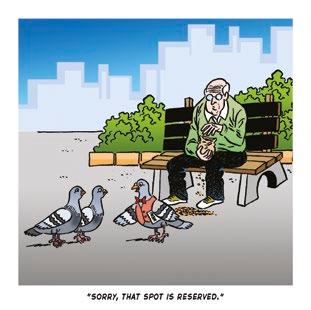
"SORRY, THAT SPOT IS RESERVED!"
I have worked right through lockdown, being a key worker. My husband, Jon, though, has been working from home. At first he didn’t mind being on his own all day; in fact, he thought it was great.
After a few months, though, he confessed, "It would be nice to talk to people."
After a few more months he confided, "I hope that pigeon comes back to the windowsill today!"
HANNAH BRYAN, LiverpoolMy ten-year-old son asked me why his grandmother was given her COVID vaccination before we were. I told him it was because she was on a list of vulnerable people. I later heard him earnestly explaining to his sister, "Granny goes first because she's on the endangered species list."
GORDON WALLACE, DundeeDuring a holiday to France, my mother and stepfather, Ian, arrived at their hotel and, after checking in, decided to venture out in the car and explore the nearest town. With no other vehicles on the grounds, they assumed they must be the only guests. The hotel was in the middle of nowhere.
A few hours later, after enjoying a meal and several drinks, they drove back to their accommodation and the car park was completely empty.
“Where is our car?” my mother asked, panicked.
“You’re in it!” replied Ian.
LUKE ITHURRALDE, County DurhamI teach art to year eight students and, at the end of term, all the pupils were making cards.
One child, whose father also works in the school, was making two cards. He had made a lovely one for me saying, "To a great art teacher" but I couldn't help but smile at his other card which was obviously for his dad. It said, "To whatever teacher you are.”
My dentist, looking at my dental X-ray, murmured, “Where is your wisdom tooth, man? I can’t see it here!” He continued to look at the X-ray film and stopped at a specific shaded area and said, “Here we go. It is hidden down here!”
JOSHUA TAYLOR, ClwydA rather portly gentleman who works in our office building was heard telling colleagues that he had been on a low carb diet for months, but it didn’t seem to be working as he hardly lost any weight.
Another man whispered so that he couldn’t hear: "He means he eats pasta while lying on the floor!"
BETHANY WEBB, ClwydA couple of years ago my husband and I decided to try out our local Spiritualist church. On the way back home we missed our train and had 45 minutes to wait for the next one so we decided to have some fish and chips.
The man serving us asked if we had a good evening. I said we had just been for a session at the Spiritualist church. He asked us if it was good or bad. My husband who couldn't believe the opportunity he had been given, quickly replied, "No, just medium!"
LINDA LUNAN, South AyrshireAs I tried to locate that, my wife who was also waiting in the room commented, “I am not surprised at all, doctor. His wisdom is not immediately obvious most of the time, to be fair!”
PAUL JOSEPH RICHARD, BelfastWhile working abroad, I made friends with a German girl who went on to marry a Lutheran pastor. When they were due to visit some years later, I decided that grace should be said before we have dinner as a mark of respect for the husband's vocation and asked one of our young sons to prepare a few suitable words.
Not one to do things by halves, I also chose a menu that I thought the visitors would enjoy, although it included none of our family's usual dishes. Maybe that is the reason why our boy, having inspected what was laid out in the kitchen, came up with the following: “For what we are about to receive, may the good Lord deliver us!”
Luckily our guests, who both spoke excellent English, saw the funny side.
MAGGIE COBBETT, North YorkshireIt’s never been easier to enjoy the world’s favourite magazine!







YES I want to subscribe to Reader’s Digest Magazine for just £3 for 3 issues (a saving of £8.37 on the shop price of £11.37 based on the cover price of £3.79 per issue). I understand that if I do not wish to continue receiving Reader’s Digest after my first 3 issues I can simply cancel my subscription by contacting customer services. If I do want to continue to subscribe after my first 3 issues I need do nothing and my subscription will automatically be renewed at the low rate of £7.50 for every 3 issues until I decide otherwise.

IT PAYS TO INCREASE YOUR
Life doesn’t always steer clear of extremes, and neither does the English language. When it comes to exceeding the bounds of moderation, how’s your vocabulary?
BY CRYSTAL BELIVEAU1. frore
A: very hairy.
B: easily excited.
C: freezing.
2. adamantine
A: long-suffering.
B: unbreakable.
C: keenly discerning.
3. havoc
A: widespread destruction.
B: harsh, guttural sound.
C: sledgehammer strike.
4. corybantic
A: wild or frenzied.
B: long-winded.
C: power-hungry.
5. elliptical
A: regarded as having overinflated importance.
B: carefully detailed.
C: concise to the point of being unclear.
6. trifling
A: dramatic.
B: insignificant.
C: involving three lovers.
7. catatonic
A: insane.
B: in a stupor.
C: overwhelmed with anger.
8. dreggy
A: extremely tired.
B: depressed.
C: filthy.
9. Cimmerian
A: deeply gloomy.
B: perfectly virtuous.
C: repulsive.
10. rococo
A: elaborately ornamental.
B: ludicrous.
C: agitated.
11. scintillating
A: violent.
B: sharply painful.
C: brilliantly clever.
12. meteoric
A: causing great surprise.
B: very sudden or fast.
C: liquefied by extreme heat.
13. stentorian
A: wicked.
B: unreasonably excessive.
C: thunderous.
14. avaricious
A: utterly hopeless.
B: extremely greedy.
C: overly sweet.
15. catharsis
A: purging of emotion.
B: bitter sarcasm.
C: state of awe.
1. frore—[C] freezing; The Nunavut winter was dark and frore.
2. adamantine—[B] unbreakable; Navya tried to talk her brother out of joining the army, but his resolve was adamantine.
3. havoc—[A] widespread destruction; Out-of-control bushfires created havoc in the Australian city of Perth.
4. corybantic—[A] wild or frenzied; Alan exploded in corybantic dancing when he learned his rare stamp could make him rich.
5. elliptical—[C] concise to the point of being unclear; The professor’s lectures were so elliptical that it seemed she was talking in code.
6. trifling—[B] insignificant; The hockey league decided the hit was too trifling to warrant suspension.
7. catatonic—[B] in a stupor; That five-hour experimental play where the cast was naked and never spoke? It left me catatonic.
8. dreggy—[C] filthy; Without running water, the squatters were living in dreggy conditions.
9. Cimmerian—[A] deeply gloomy; Inga really hated November’s Cimmerian weather.
10. rococo—[A] elaborately ornamental; When it comes to furnishings, my husband’s tastes run toward the rococo.
11. scintillating—[C] brilliantly clever; Pianist Glenn Gould’s virtuosity in interpreting Bach was scintillating.
12. meteoric—[B] very sudden or fast; From interning at 18 to becoming CEO at 30, my sister’s rise at the firm was meteoric.
13. stentorian—[C] thunderous; The preacher’s stentorian voice allowed him to be heard above the din in the tent.
14. avaricious—[B] extremely greedy; With billions in the bank, the tech company became avaricious, devouring smaller start-ups.
15. catharsis—[A] purging of emotion; Writing down the story of his Second World War tour was a catharsis for Terrance.
VOCABULARY RATINGS
7–10: fair
11–12: good
13–15: excellent
1. Underwater stuntwoman Katrin Gray opened the world’s first school for what kind of specialised swimming?
2. The 2019 UK hit song “Let Nature Sing” featured what type of wildlife to raise awareness of their endangerment?
3. Built in 1919, El Ateneo Grand Splendid has served as a theatre, cinema and, now, a bookstore in which city?
4. Participants in the European Case Rodeo, clad in cowboy hats, compete using what?
5. What country legislated compulsory voting in 1924 and had a voting rate of more than 90 per cent in the 2019 elections?
6. Which film about a woman’s survival in the aftermath of war in Kosovo won three awards at the 2021 Sundance Film Festival?
7. The mine at Wieliczka, Poland, has been in operation since the 13th century. What does it contain?
8. The Indonesian all-girl band Voice of Baceprot has garnered international attention for its take on what kind of music?
9. Which European country became the world’s first to sell more electric than gasoline-powered new cars in 2020?
10. Who wrote, in his fantasy series Discworld, “The pen is mightier than the sword if the sword is very short and the pen is very sharp?”
11. What unusual sport, originating in Britain, combines a household chore with physical challenges?
12. According to a recent academic study, men will unconsciously mimic the body language of other men if they are doing what?
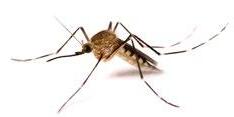
15. An international team of scientists recently found a way to prevent mosquitoes from transmitting what disease to humans?
13. What group arrived in northern Scandinavia over 10,000 years ago?
14. What was installed at Prague’s Vinárna ˘ Certovka walkway to prevent pedestrian congestion?
Challenge yourself by solving these puzzles, then check your answers on p139
How to play:
Draw a line from each number to an outlet. Each line should pass as many empty squares as the number indicates. No square remains empty, and no outlet remains unused.
ExamplE:
How to play:
Enter in each row and column the letters A, B and C in such a way that no row or column contains the same letter twice.
The letters outside the grid indicate what letter is encountered first from the direction of the arrow.




Did you know that the Dutch police force’s car of choice in the 1960s was a Porsche? Back then, the absence of speed limits on Dutch highways saw a worrying spike in accidents and so, the police force needed a vehicle that was reliable, fast and had an open top so that officers could stand up in their cars and direct traffic. The solution? A Porsche 356, which made a watertight case with its balance of performance, reliability and of course, its cabriolet capabilities
via autobuzz.my
WIN £30 for every reader’s joke we publish!
Go to readersdigest.co.uk/contact-us or facebook.com/readersdigestuk
I’m starting a petition to rename the country AAA United Kingdom, to make using drop-down menus easier.
Comedian GARY BAINBRIDGE
I’m going to convince Gen Z that MySpace was pronounced like Versace. Journalist MARIE LE CONTE
When I go to the barber, I take a photo to make sure that he gets my trim just right. It’s of his pet dog tied up in an abandoned warehouse. Seen on Twitter
I’ve got a beautiful tattoo of a chameleon. Somewhere…
Writer PAUL BASSETT DAVIES
I tried to reset my password to “beef_ stew” but my computer said it wasn’t stroganoff. Seen on Twitter
Actors who could cure my lisp? I’m pretty sure Anne Hathaway but I’m going to ask Colin Firth.
Comedian OLAF FALAFEL
Brontosaurus: How come you never wear the jumper I bought you?
T Rex: I’m not sure that I could pull it off. Seen on Facebook
My girlfriend thinks that I’m pretentious. She walked in on me reading a copy of a book on existential philosophy and said, “Oh
People say being a waiter is a bad job, but hey, it PUTS FOOD ON THE TABLE!
Seen online
my God, are you for real?” I told her that’s what I’m trying to figure out!
Seen on Reddit
My wife recently adopted a pet monkey. She’s already so fond of it that she’s suggested we let it sleep in our bed. “But what about the smell?” I protested.
“Well, I’ve lived with it for 25 years, so I’m sure the monkey can put up with it,” she replied.
ANGIE BORODZICZ, via email
I like to randomly tweet things like, “I’m onto something.” That way, if I die, there will be more questions than answers.
Comedian FUNNYMAN FIELDS
Why hasn’t KFC renamed its menu, “the bucket list?”
Seen on Twitter
A man dies and finds himself sent straight to hell. Satan meets him,

DESERT RAIN FROGS ARE BLESSED WITH NATURALLY GRUMPY FACES. THESE ARE SOME OF OUR FAVOURITES via sadanduseless.com


shows him the doors to three rooms, and says he must choose one room to spend eternity in.
In the first room, people are standing in dirt up to their necks. The man says, “Not this one, let me see the next room.” In the second room, people are standing in dirt up to their noses. He says no again.
Finally Satan opens up the door to the third room. People are standing with dirt up to their knees, drinking coffee and eating pastries. The man says, “I pick this room.” Satan says OK and starts to leave, and the man wades into the dirt and starts to pour himself some coffee.
As he reaches the door, Satan turns back and yells, “OK, coffee break’s over. Everyone back on your heads!”
Seen on Reddit

Twitter users share some of their favourite quotes from their dear old mums
@BdwayBrooke: Someone recently annoyed my mum in the supermarket so she looked at them and asked, “Excuse me, can you please tell me which aisle the manners are in?” Savage moment.
@SteveAustin1984: One time, my mum texted me, “Where is your phone?”
Can everybody here for the yodelling contest please form an orderly orderly orderly orderly queue?
Submitted via email
I work as a Customs Officer, and yesterday was my yearly review. It didn’t go very well, apparently they think I’m borderline incompetent. Seen on Twitter
I tried to keep it a secret that we had a cat in the bakery, but there was a paw in my flan.
Comedian GARY DELANEY@Marisa_Rosie22: I told my mum that she was invading my personal space and she replied, “You came out of my personal space”. I just looked at her and said OK.
@EdwardSchmidtii: My mum can never get the name of the pizza place, Papa Johns, right. Some of my favourite attempts have been, Magic Jack’s and Doctor
Domino’s.CROSSWORD ANSWERS
Across: 9 Suffocate, 10 Hoyle, 11 Animals, 12 Senator, 13 Vandalism, 14 Pros, 17 Insects, 20 Surface, 21 Obit, 22 Elsewhere, 27 Saddens, 28 Control, 29 Needs, 30 Authentic
Down: 1 Aswan, 2 Africa, 3 Cowardice, 4 Damsel, 5 Persists, 6 Phone, 7 Hysteria, 8 Depressed, 15 Limousine, 16 Archangel, 18 Skin-deep, 19 Salesman, 23 Excite, 24 Rarity, 25 Beast, 26 Black
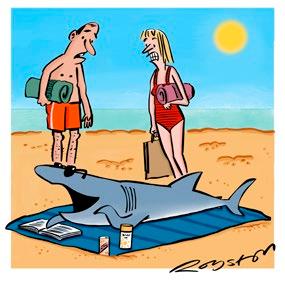
Think of a witty caption for this cartoon—the three best suggestions, along with the cartoonist’s original, will be posted on our website in mid-June. If your entry gets the most votes, you’ll win £50.
Submit to captions@readersdigest.co.uk by JULY 7. We’ll announce the winner in our August issue.

Our cartoonist can celebrate in style this month, as his caption, “Stay safe!”, proved your runaway favourite, taking 80 per cent of the votes. Want to wipe that smug smile off his face? Enter next month’s competition using the details above and next time the crown could be yours…
cartoons by Royston Robertson


The stage and screen legend on lockdown, knighthood and marrying the love of his life
Heart disease kills twice as many women in the UK as breast cancer—so why is it considered to be a man’s problem?

If I Ruled The World Jessamyn Stanley
The world according to the body positivity sensation

Humans throw out about 11.2 billion tons of rubbish every year. But Veena Sahajwalla, a materials scientist and engineer at the University of New South Wales (UNSW) in Sydney, Australia, has devised a novel approach to tackle the world’s rubbish problem and revolutionise recycling: waste microfactories.
While most recycling plants simply refashion old materials into new versions of the same product, Sahajwalla’s microfactories utilise thermal technology to “re-form” them into something completely different. Her first microfactory, launched in 2018, turns discarded
computer circuit boards into metal alloys such as copper and tin. Her second, operational since 2019, repurposes scrapped plastics into filaments for use in 3-D printers. Both sites are funded by UNSW and are housed within the university.
The microfactories, which are still in the development phase, range in size from 50 to 100 square metres, and are capable of operating with as few as two workers.
“Recycling is normally seen as very much about large infrastructure and massive facilities,” says Sahajwalla. “What I wanted to do was turn that notion on its head.”
We are fearful of the present, uncertain of the future and longing for the past that used to be.
Even in the Blitz of World War 2 people went about life as best they could. But, the country fell silent to Covid-19
How did lockdown a ect you?
People lost their jobs and incomes, children’s schooling was interrupted, weddings were postponed and even funerals could not occur in the usual manner.
Unable to bid farewell to a loved one was one of the saddest events in lockdown. Death lives long in the minds of those who are left behind.

We saw ‘the good, the bad and the ugly’ of human nature being played out during lockdown.






Could things have been done di erently? Would they have made a di erence?
Would you have chosen to be in the shoes of the Prime Minister in handling this crisis?
LOCKDOWN 2020 touches the lives of most people. Read it and identify your life in the words of the author.


We have to accept the new normal and look after ourselves. We would then be able to return to a semblance of the quality life we had.
Will Covid-19 be the last or could it happen again? The answer is in LOCKDOWN 2020















www.barnesandnoble.com




































orders are subject to availability and acceptance. Please allow up to 28 days for delivery.



















(1f), also with the help of trusted suppliers. You can find further information in our privacy statement, which you can see at any time on www.windsormint.co.uk or request in print from our customer service. You can cancel the use of your details for marketing purposes at any time by sending a simple message to Windsor Mint, 11 Lowesmoor Wharf,










